GUARDIAN
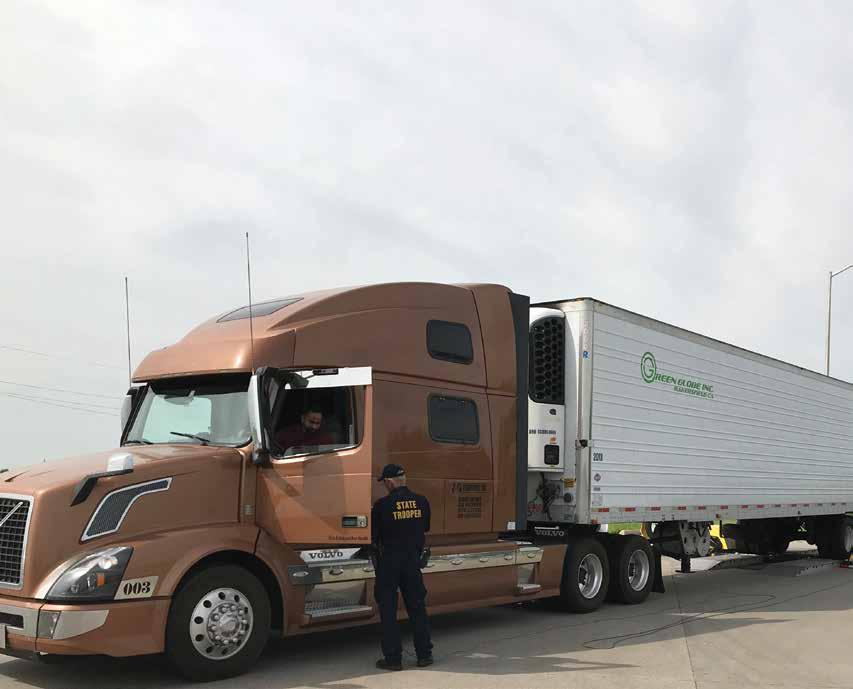


GUARDIAN
“Guardian” is published quarterly by the Commercial Vehicle Safety Alliance with support from the Federal Motor Carrier Safety Administration. CVSA and FMCSA are dedicated to the government and industry working together to promote commercial motor vehicle safety on North American highways.
Copyright 2025, CVSA. All rights reserved. No part of this issue may be reproduced without written permission from the publisher.
For comments, suggestions or information, email communications@cvsa.org.


CVSA is looking for interesting, relevant content for its quarterly magazine. We would be happy to consider your news, ideas, insights and articles on issues facing the commercial motor vehicle safety community for upcoming editions of “Guardian” magazine.
The deadlines for upcoming editions are available at www.cvsa.org/guardianmagazine/deadlines-for-submissions.
Questions? Please contact CVSA Writer-Editor Emily Moorhead at emily.moorhead@cvsa.org.

By Capt. John Hahn, Motor Carrier Safety Section, Colorado State Patrol; CVSA President
There is no shortage of information out there regarding leadership. A quick search yields countless options to improve your own leadership skills, including classes and seminars customized to you and your organization’s specific needs. One can pursue undergraduate and graduate studies in leadership at a variety of colleges and universities. A recent search on a certain wellknown online retailer revealed over 60,000 books dedicated to leadership. However, if you search online for the term “commercial vehicle enforcement leadership,” the results are a little less voluminous, with no options.
If you speak to just about anyone in our commercial motor vehicle (CMV) enforcement community, you will hear many of the same challenges related to leadership development. We find that many times, individuals in positions of leadership change with some frequency as people are promoted, retire or simply move on in their professional lives. We also find that many people entering CMV enforcement leadership roles have little prior knowledge of the new position they are taking on.
I have often shared my own story of applying for a transfer within my own department that placed me in my first position related to CMV safety. I had attended the North American Standard Inspection Part A Training Course many years prior, but, needless to say, my skills and recollection of the nuances of this particular discipline were not very sharp. My transfer was approved, and even before my official report date in the new position, I
was sent to the 2014 CVSA Workshop in Los Angeles, California. I wandered around, trying to figure out where I was, what I should be doing, what was going on and what my place was in all of it. If not for a couple of CVSA staff, I likely would still be drifting around that hotel in downtown Los Angeles.
Back home, my reality was similar. Sure, I generally knew my role in my agency, but I had no idea how the pieces fit together to form the larger picture. From understanding federal regulations to figuring out where to get help from peers and from trying to get a handle on the verbiage to learning who made up all the components, it took me some time to figure it all out. I would say that I am still very much learning. The point is that within CMV enforcement, each individual’s role at every level is nuanced and complex, and it takes significant time to get up to speed. The good news is that CVSA is poised to help.
In June 2024, the CVSA Board of Directors discussed the concept of CVSA creating a leadership development program, and discussions continued during the December 2024 board meeting. The purpose of the leadership development program is not to reinvent the many existing instructional materials or courses widely available related to leadership. As I mentioned, there is no shortage of reading material and courses about leadership in general. The purpose is to provide a host of resources, mentorship, job aids and guidance to those new to supervising or running a CMV enforcement program.
A few years ago, when we set out to develop our existing strategic plan, one of the issues frequently cited by our membership was concern about developing succession and knowledge-retention planning. Very clearly, the members of our organization genuinely desire to find ways to tackle the loss of institutional knowledge that comes with turnover, be it related to reassignment or retirement. This initiative seeks not only to stem the tide of what is often referred to as “brain drain” but also help to accelerate new members’ knowledge in CMV safety discipline and advance their understanding and assimilation into CVSA so we can more efficiently develop leaders within the Alliance. Ultimately, the goal is to provide effective resources for those new to this arena while also enhancing some of the tools for our existing membership.
As I look down the road, I am very excited about what is ahead in enhancing our member resources. One of the greatest responsibilities of people in a leadership role is to help develop those coming after them. Interestingly, if you use your favorite search engine and look up the term “CMV enforcement leadership,” the first two items that pop up are related to CVSA. As leaders in the CMV safety community, I believe it is not just our responsibility to develop those who come next – it is an obligation. I am proud to say that using the strength of our membership to fulfill that obligation is something we are well-poised to achieve. n


By Collin B. Mooney, MPA, CAE, Executive Director, Commercial Vehicle Safety Alliance
It may not be widely known, but as the roadside North American Standard Inspection (NASI) Program continues to evolve, it requires considerable dedication and attention to the ongoing challenges facing roadside enforcement and inspection practices. The roadside North American Standard Out-ofService Criteria, CVSA decals, inspection procedures, inspection bulletins, operational policies, training materials, inspection tools and equipment, data quality and uniformity initiatives all require ongoing maintenance and improvements for the roadside inspection program to be kept current, applicable and relevant.
However, although the roadside NASI Program continues to be our most successful endeavor, the Alliance has so much more to offer.
All our programs and activities have been specifically designed to highlight and elevate the importance of commercial motor vehicle (CMV) safety throughout North America. However, these efforts require continued maintenance and fresh perspectives on improving CMV safety within our communities.
The Alliance offers a forum for the motor carrier industry and the CMV enforcement community to collaborate to improve CMV safety. CVSA’s committees and programs allow its participants to share ideas and perspectives on a variety of CMV safety issues, including legislative direction, regulatory applicability, cross-border challenges, roadside inspection data quality, industry and stakeholder concerns, and technological advancements.
Being involved with and participating in CVSA’s committees and programs gives you first-hand information to be channeled back to your jurisdiction in the pursuit of quality, uniform in-service training and professional development. By embracing timely insight into the changes impacting CMV safety, you can take that knowledge and apply it to improving your jurisdiction’s safety and enforcement programs and day-to-day operations.
On the legislative front, CVSA gives our jurisdictional members a powerful voice on Capitol Hill. Members of U.S. Congress on both sides of the aisle value the enforcement community’s input regarding CMV safety issues. The Alliance as a whole can respond quickly when a legislative or regulatory issue arises, and time is often of the essence in responding to congressional inquiries or educating policymakers. CVSA can also coordinate member advocacy priorities and leverage its relationships on Capitol Hill.
CVSA strives to be a strong, unified voice of the CMV enforcement community to ensure all legislation and regulations demonstrate clear applicability and enforceability. Uniting through CVSA elevates awareness and prioritizes issues.
The Alliance serves as a coordinating function for regulatory development and improvement. By leveraging the subject matter expertise of the roadside inspector, the Alliance is well-positioned to petition for changes to the regulatory framework to have clear, enforceable regulations for all industry stakeholders and the CMV enforcement community. In addition, the Alliance monitors the pulse of emerging CMV safety concerns and issues through the timely monitoring and reporting of regulatory developments.
CVSA also offers members a more global view of regulatory development issues, allowing U.S., Canadian and Mexican jurisdictions to share best practices and to see how problems arise and are resolved elsewhere.
There are many examples. The speed limiter proposed rule is currently undergoing rulemaking in the U.S., but it has already been implemented in parts of Canada. Then, there are the challenges associated with the certification of electronic logging devices (ELD). Hearing about the benefits and challenges associated with the implementation of speed limiters and ELDs helps U.S. jurisdictions as they, along with CVSA, guide the formulation of U.S. policy. Another example would be the regulatory efforts and stakeholder engagement
through the North American Cargo Securement Harmonization Public Forum and the development and maintenance of a standardized and uniform North American Cargo Securement Model Regulation. These opportunities for information sharing are essential, and these types of conversations may not take place without CVSA providing a forum.
Another key value of the Alliance is the network of contacts it offers and sustains. It is invaluable to be able to pick up the phone or email someone in another jurisdiction –someone you met and networked with at a CVSA event – for information regarding state, provincial or territorial laws, regulations, inspection reports, driver and/or motor carrier domicile issues, etc. Many CVSA members have been able to leverage this web of contacts to obtain information regarding a whole host of issues that would have proved challenging within a short period of time without that direct professional contact.
Lastly, the value of the personal and professional relationships CVSA fosters cannot be understated. Throughout the years, I’ve seen evidence of this sense of community at every CVSA meeting and event. The members of the Alliance are not only professional colleagues but also friends, and this is an intangible benefit that can only be realized through active CVSA membership and engagement in our committees, programs, events and conferences. For example, the North American Inspectors Championship provides a venue that celebrates the roadside inspector community and seeks to engage and challenge inspectors while often identifying future leaders for their agency and the Alliance.
The value of CVSA depends largely on what you put into it. Simply put, the more you put into it, the more you get out. To have an impact and make a difference, you need to recognize your individual strengths, look for opportunities to contribute “your footprint” within the organization and be part of the front line of change in this ever-changing environment of CMV safety improvement. n
By Staff Sgt. Carl D. Huddleston, Assistant Commander, Motor Carrier Enforcement Unit, New Hampshire State Police
New Hampshire State Troopers assigned to Troop G participated in a regional commercial motor vehicle (CMV) enforcement blitz on Oct. 29-31, 2024, as part of the Federal Motor Carrier Safety Administration (FMCSA) Eastern Service Center crash initiative. The blitz was coordinated with 11 other jurisdictions within the FMCSA Eastern Service Center, and 23 federal and state partner agencies participated.
The objectives of the blitz were to deter persons from operating CMVs and non-CMVs in a variety of unlawful modes, including, but not limited to, aggressive driving, unlawful speed, following too closely, improper passing, unsafe lane changes, failing to move over, failing to wear a safety belt, distracted driving, driving under the influence, hours of service violations, commercial driver
license violations, medical certification, CMV credentialing, prohibited handheld electronic device usage and enforcement of state weight limit regulations.
During the blitz, state troopers, motor vehicle inspectors and FMCSA staff:
Completed 2,357 inspections
Detected 2,643 violations
Placed 160 drivers out of service
Placed 251 vehicles out of service
Issued 340 citations
This high-visibility event across multiple jurisdictions highlighted efforts by enforcement personnel to eliminate traffic fatalities by reducing traffic crashes involving large trucks, buses and passenger vehicles. n

Region I
Connecticut, Delaware, District of Columbia, Maine, Maryland, Massachusetts, New Hampshire, New Jersey, New York, Pennsylvania, Puerto Rico, Rhode Island, U.S. Virgin Islands and Vermont
Region II
Alabama, American Samoa, Arkansas, Florida, Georgia, Kentucky, Louisiana, Mississippi, North Carolina, Oklahoma, South Carolina, Tennessee, Texas, Virginia and West Virginia
Region III
Colorado, Illinois, Indiana, Iowa, Kansas, Michigan, Minnesota, Missouri, Nebraska, North Dakota, Northern Mariana Islands, Ohio, South Dakota and Wisconsin
Region IV
Alaska, Arizona, California, Guam, Hawaii, Idaho, Mexico, Montana, Nevada, New Mexico, Oregon, Utah, Washington and Wyoming
Region V
Alberta, British Columbia, Manitoba, New Brunswick, Newfoundland and Labrador, Northwest Territories, Nova Scotia, Nunavut, Ontario, Prince Edward Island, Quebec, Saskatchewan and Yukon
By Sgt. Jaclyn DeVore, Connecticut Department of Motor Vehicles
How are states implementing commercial motor vehicle (CMV) education to promote safer roadways?
Connecticut law enforcement is comprised of both state and municipal police departments. Unlike most jurisdictions, most of our state’s crashes occur on interstate highways. Only state officers are certified to conduct North American Standard Inspections, which creates a lack of information regarding CMV enforcement among municipal officers.
Crashes may be overrepresented on interstate highways, but we all know that CMVs travel on and require state and local roads for society to exist and function. Oil and propane trucks making deliveries to residences; UPS and FedEx making local package deliveries; triaxles and tractor-trailer units in combination making deliveries to local farms, factories and warehouses; and school buses transporting students to and from school are all examples of CMVs on local roads. Certified officers have statewide jurisdiction, but we also rely on our municipal/local officers to be aware of CMV hazards, respond to crashes and conduct enforcement, making education of local law enforcement officers paramount to ensuring public safety.
As part of law enforcement basic recruit training, all academy classes that attend the police academy are required to complete a four-hour block on CMV law taught by the lead agency. During this class, recruits learn about commercial driver’s licenses (CDL), endorsements and restrictions, as well as how Title 14 and Connecticut motor vehicle law can be applied when encountering an incident involving a CMV and driver.
This comprehensive class has two separate portions. The first half is a classroom presentation on the following topics:
• Public transportation endorsements
• Medical certificates
• Operating under the influence
• Hours of service/electronic logging devices/logbooks
• Registration and insurance
• Size and weight
• Parts and accessories necessary for safe operation
• Truck and bus crashes
• Load securement
• Behaviors indicative of human trafficking and drug trafficking

After completing the classroom portion, we escort the academy recruits outside, where a CMV is waiting for a hands-on demonstration on how to approach the CMV safely. The instructors go over basic approaches, what to look for in the cab, what documentation should be presented, basic safety violations that would warrant a further inspection/analysis of the driver or vehicle, vehicle identification tags, and trailer registration boxes/locations. The instructors also allow the CMV driver to interact with the recruits by providing positive feedback on his job as a CDL driver, which creates great public relations.
Together with the Connecticut Federal Motor Carrier Safety Administration field office, we developed a quick-reference visor card to make CMV encounters easier for municipal officers. These cards include a CDL flowchart, a QR code for endorsements, common CMV state statutes
and a law enforcement-specific call line to our agency for additional support.
Teaching this class allows us to share pertinent information through classroom presentations, hands-on demonstrations and quick-reference visor cards. It also provides transparency and integrates state and local law enforcement efforts to reduce CMV crashes and ensure the safe travel of our families on Connecticut’s roads. n
A visor card with commonly issued CMV citations, given to new municipal officers.
By Joseph Havranek, Chief Motor Carrier Investigator, New York State Department of Transportation
The New York State Department of Transportation (NYSDOT) purchased four drones with funding from the Motor Carrier Safety Administration Program. The goal is to explore using the drones in some proof-ofconcept efforts, including:
• Inspecting interior cargo areas and tops of commercial motor vehicles (CMVs)
• Monitoring highways and side streets used by CMVs to bypass inspection sites
• Conducting site security
• Serving as virtual inspection sites, using drones to replace hard infrastructure to do prescreening of CMVs
The NYSDOT Office of Modal Safety and Security drone pilots and management met on Dec. 19, 2024, at the NYSDOT Voorheesville residency, where they conducted drone pilot missions and training. One of its mobile command center trailers was also utilized for this training.
Pilots/Inspectors Adrian Armpriester, Robert Kassin, Justin Coon and Adam Silverstein operated the unmanned aircraft systems, also known as UAS. Also on site were Aviation Senior Analyst Colton Dlugolecki, Information Technology Division Program Manager Martin Duffy and Chief Motor Carrier Investigator Joe Havranek. n
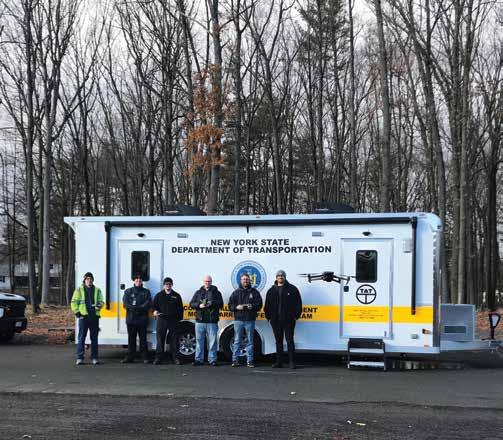
By Jonathan Nicastro, Director, Motor Carrier Compliance Bureau, New York State Department of Transportation
As a part of NYSDOT's Operation Safe Drive Initiative, supervising inspector Justin Coon teamed up with officers from the Suffolk (New York) and Nassau (New York) County Police, the Federal Motor Carrier Safety Administration (FMCSA) and NYSDOT commercial vehicle inspectors in Suffolk County on Nov. 20, 2024.
The cooperative group inspected over 75 vehicles using performance-based brake testers (PBBT). Multiple vehicles were placed out of service for brake violations, and several wheel ends also failed inspection. The group reported that it was its most productive inspection blitz with the PBBT technology to date and plans to hold additional PBBT inspection initiatives. n
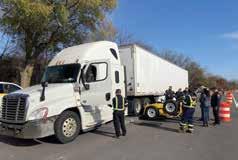

By Chief Troy Thompson, Office of Commercial Vehicle Enforcement, Florida Highway Patrol
During the three days from Oct. 1-3, 2024, partner agencies participated in the fourth of five SafeDRIVE (Distracted-Reckless-ImpairedVisibility-Enforcement) waves scheduled in 2024. The strategic objectives of SafeDRIVE are to provide high visibility enforcement along targeted corridors in combination with education and outreach events to achieve the mission of preventing crashes and reducing the number of fatalities, injuries and property damage. Although primarily driven by state agencies, SafeDRIVE partners include local law enforcement agencies and the Federal Motor Carrier Safety Administration. These participate in three-day waves each quarter to promote enforcement and outreach efforts on passenger vehicles and commercial motor vehicles (CMV).
Although Hurricane Milton heavily impacted the fourth wave, member agencies completed 5,688 inspections. During the wave, 352 drivers and 753 vehicles were placed out of service. A total of 980 drivers (231 CMV and 749 non-CMV) were issued citations for moving infractions. Speeding was the most issued citation, with 94 CMV drivers and 636 non-CMV drivers cited.
From Nov. 18-20, 2024, partner agencies participated in the fifth of five SafeDRIVE waves scheduled for the year. During this wave, member agencies completed 8,006 inspections, resulting in 456 drivers and 1,054 vehicles being placed out of service. A total of 846 drivers were issued citations for moving infractions. Speeding was the most commonly issued citation, with 206 CMV drivers and 533 non-CMV drivers being issued citations for unlawful speed. n
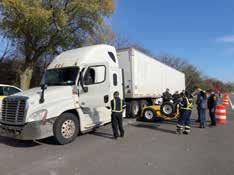
On Oct. 31, 2024, the Florida Highway Patrol (FHP) Commercial Vehicle Enforcement –Lake City partnered with the Florida Department of Transportation (DOT) to host the third annual Truck-or-Treat. More than 1,600 people attended the event, where children received Halloween goodies and parents had a sense of safety and security. n
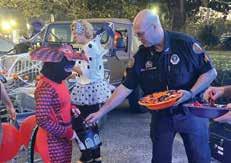
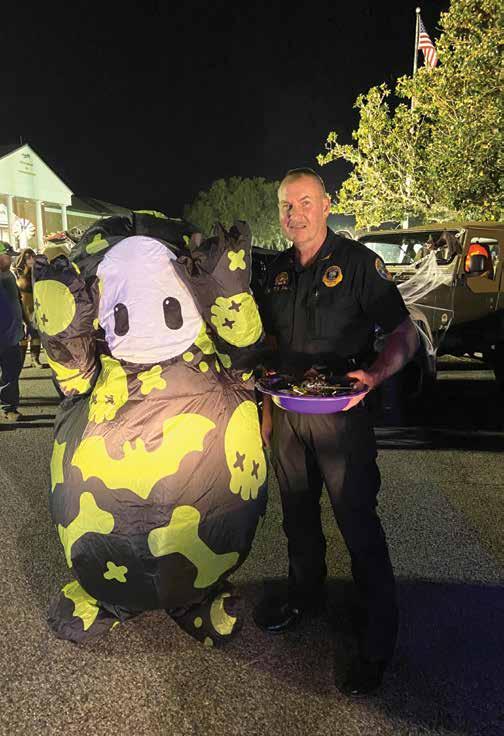
On Nov. 4, 2024, Sgt. Casey Moore assisted the Florida Trucking Association (FTA) with a voluntary inspection detail at the I-75 Wildwood Weigh Station in Central Florida. Sgt. Moore is a member of the FTA’s Safety Management Council, assisting FTA with several details throughout the year focused on CMV safety. CVE troopers Joseph Sims, Chris Powers and James Whitmore also assisted, providing educational outreach to approximately 30 trucking company safety officials. During this detail, drivers entering the scale facility were randomly asked to submit to a voluntary inspection, which the trucking company safety officials conducted themselves. CVE troopers guided them, pointing out things to look for during pre-trip inspections, such as potential (or existing) violations. The drivers were included in the walk-around inspections of the vehicle, proving to be a learning experience for all. n

From Nov. 17-24, 2024, FHP provided refresher training to members who are CVSA Level VI certified and to members who are qualified to use a Radiological Isotope Identification Device (RIID). The training occurred in Lake Mary, Florida, and provided valuable updates to members participating in radiological enforcement details and screening events. n
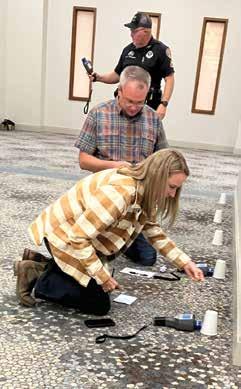
On Nov. 9, 2024, FHP supported the Florida Concrete and Products Association by participating in judging their Safety and Skills Competition. This was the association’s 23rd annual event, and FHP is proud to have partnered with them for this event throughout the years. FHP members also provided safety outreach materials to their members. n
Continued on next page
Continued from page 7
During the weeks of Nov. 11-15, 2024, and Nov. 18-22, 2024, FHP and the Mississippi Highway Patrol (MHP) partnered on a Post-Crash Inspection Training Course. FHP provided instructors Capt. Bryant Gay and Tpr. Jacob McMahan, along with a trailer full of training aids. MHP provided lodging, training facilities and coordination with the trucking industry to host the course.
In total, 21 inspectors/investigators from Mississippi, Louisiana and Alabama participated in the training, which provided classroom and hands-on activities to advance student knowledge and expertise of CMV inspections, particularly following a crash event. Upon completing the course, investigators/inspectors are better equipped to complete a comprehensive post-crash inspection, secure and collect evidence, identify pre- and post-crash violations, and properly document defects on inspection and additional reports. n


Two trainers from Florida and Mississippi and 21 students from Mississippi, Louisiana and Alabama participated in the training event.
On Oct. 23, 2024, Sgt. Moore participated in a ceremony at the Brooksville (Florida) Walmart Distribution Center honoring long-time professional driver Marcus Brogdon on achieving 4 million safe miles with the company. Marcus received a certificate from FHP recognizing his professionalism and dedication to safe driving on the roadways. Walmart recognizes these major milestone drivers throughout their careers, presenting them with a new company truck with special graphics, a generous safety bonus and a steak cookout with their fellow employees in their honor. n

On Nov. 25, 2024, FHP partnered with Tallahassee Celebration Baptist Church and our allied law enforcement agencies to give back to our community. In total, approximately 15 troopers and other law enforcement officers delivered 527 meals to underprivileged families. Each meal included a turkey, side dishes and a pie. This was the seventh year FHP participated in this event. n

On Nov. 21, 2024, Lt. Natalie Ruff and Sgt. Moore conducted an outreach presentation for Marion Technical College’s Commercial Vehicle Driving Program. Lt. Ruff and Sgt. Moore have been giving safety presentations at this commercial driver’s license (CDL) school for many years, reaching every new CDL driver this school produces with the thought that introducing new drivers to the enforcement side of trucking early on would encourage them to make more safety-conscious decisions. The training includes teaching new drivers what is expected of them during an inspection and what they can expect from enforcement officers. Topics covered included safe driving, mobile phone use or texting in CMVs, the roadside inspection process, Safety Measurement Scores and human trafficking prevention. n
Continued on next page
Continued from page 9
On Nov. 15, 2024, Sgt. Moore conducted an outreach presentation for the Southeastern Wood Producers Association quarterly meeting. Approximately 60 logging company owners and log truck drivers attended Sgt. Moore’s presentation on the safety regulations and safe operation of their trucking fleet while on the highways. While log trucks sometimes get a bad reputation, most companies genuinely strive to be safe while on the road. Sgt. Moore’s presentation included load securement, safe driving, proper pre-trip inspections, weight and dimensional rules, etc. n
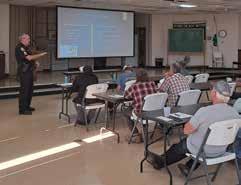
On Oct. 30, 2024, Sgt. Moore, Tpr. Mike Orton and FHP Auxiliary Maj. Don Flynn participated in a safety day at Landstar Systems Inc., a large national trucking company based in Jacksonville, Florida. Landstar employs over 9,000 independent owner-operators, moving freight throughout the U.S. Landstar held a safety day at their corporate headquarters and invited FHP to participate. The “no zone” tractor-trailer was used to show hundreds of employees the potential dangers of driving around large trucks. Most of the office employees had previously never been inside a large truck, and at this event, they were able to get the visual perspective of a truck driver, seeing all the blind spots that surround large trucks. The FHP rollover simulator was also utilized, demonstrating the dangers of not properly wearing a seatbelt. n

On Dec. 5, 2024, Lt. Ruff and Sgt. Moore conducted an outreach presentation for the University of Florida’s (UF) Pest Management University (PMU) in Apopka, Florida. PMU is a cooperative effort between the pest control industry, UF Institute of Food and Agricultural Sciences and the Florida Department of Agriculture Consumer Services. This three-day event provided employees of commercial and household pest management, lawn care, and termite and rodent control companies with valuable resources for many different aspects of their day-to-day operations. Topics included safe driving and CMV regulations. FHP members provided a mock roadside inspection in the parking lot. n

On Dec. 12th, 2024, Lt. Ruff and Sgt. Rod Howard participated in Wreaths Across America at the Walmart Distribution Center in Alachua, Florida. Following a brief wreath-laying ceremony at the facility, they provided an escort for a Walmart tractor-trailer transporting Christmas wreaths to the Wildwood, Florida, area. The trucks then continued to national cemeteries in Central and Southern Florida.
Every year, the Wreaths Across America organization places hundreds of thousands of Christmas wreaths on the graves of American soldiers. For the 2024 holiday season, more than 2 million volunteers and supporters gathered to remember, honor and teach at more than 4,000 participating locations in all 50 states, at sea and abroad.
Several trucking companies participated in the logistics of moving the wreaths from where they are made in Maine to cemetery locations all over the country. Walmart (also a member of the Florida Trucking Association) is one of those carriers that generously donates its trucks and drivers to this wonderful cause across the U.S. n

On Nov. 13-14, 2024, Sgt. Moore conducted a safety presentation at the Jacksonville, Florida, location of Builders FirstSource, a national building supply company. Builders FirstSource employs over 29,000 people and operates in 43 states. Over two days, Sgt. Moore met with around 50 drivers responsible for delivering construction materials to job sites every day. Sgt. Moore discussed items such as conducting a thorough pretrip inspection, use of cell phones/texting, load securement, safe driving and the roadside inspection process. A mock CVSA Level II Inspection was also completed on one of the company’s trucks. n

By Sgt. Gregory Handy Jr., Louisiana State Police Transportation Safety Services
Late last year, the Louisiana State Police (LSP) Transportation Safety Services – Commercial Vehicle Enforcement Division (CVED) decided to take a new approach to its outreach efforts. Traditionally, CVED outreach focused more on commercial motor vehicle (CMV) carriers, CMV drivers and licensed non-CMV drivers. To expand its educational outreach, CVED personnel contacted the Louisiana State University Center for Analytics and Research in Transportation Safety (CARTS) to understand who could best benefit from targeted outreach efforts.
CARTS provided data showing that non-CMV drivers ages 25-34 were involved in the most CMV crashes in Louisiana. Since Louisiana does not offer continuing driver education once a driver's license is obtained for the first time, CVED decided to engage with nonCMV drivers before they reach the 25-34 age group. Therefore, it was agreed that the target audience should be teen drivers ages 15-18.
CVED partnered with the Federal Motor Carrier Safety Administration (FMCSA), South Louisiana Community College and industry partner L&B Trucking to host a program called the Safe Drive Commercial Motor Vehicle Event. This event aimed to educate teen drivers on sharing the road safely with CMVs. During the event, teens participated in a hands-on demonstration, allowing them to operate a CMV simulator. Other topics included the dangers of impaired and distracted driving, the importance of wearing seatbelts and how to interact with law enforcement.
Through partnerships such as these between law enforcement and industry, CVED is now better equipped to provide the necessary tools to help teen drivers make better decisions when driving around CMVs. Moving forward, CVED plans to present the program once per quarter to high school students around Louisiana. The interaction with students is encouraging, and CVED remains committed to educating teens around the state on the importance of driving safely around CMVs. Such positive interactions can lead to safe driving behaviors and possibly inspire future law enforcement officers or CMV drivers. n


By Master Sgt. Victor McCarty, Mississippi Commercial Transportation Enforcement Division, Mississippi Department of Public Safety
The Mississippi Commercial Transportation Enforcement Division (CTED) has continued to grow and thrive within the Mississippi Department of Public Safety under the leadership of Lt. Col. Matthew Lott. As a newly formed division, CTED has quickly made its mark, setting a high standard for commercial motor vehicle (CMV) enforcement in Mississippi.
Through legislative advancements, enhanced officer training and operational successes, CTED has significantly improved the enforcement of CMV regulations, contributing to safer highways and supporting the state's public safety mission.
The year 2024 brought a host of notable achievements and milestones that solidified CTED’s reputation as a top-tier law enforcement agency. The following update highlights these accomplishments and showcases the division’s ongoing growth and commitment to excellence and safety.
One of the key factors contributing to CTED's growth and success has been the legislative support that empowers our officers and strengthens our operations. Notable legislative advancements from the 2024 regular session include:
Pay Raise (HB874): This critical legislation ensured CTED officers received welldeserved compensation increases, reinforcing our commitment to recruiting and retaining top talent.
Speed Detection (HB1002): The approval of speed detection technology equips CTED with the tools needed to enforce traffic laws effectively and promote safer roads across Mississippi.
Intoxilyzer (HB1015): With the authorization of intoxilyzers, CTED officers can now better address impaired driving, enhancing public safety.
Voluntary Inspection of CMV (HB751): House Bill 751 provides CMV operators with the opportunity for voluntary inspections, a proactive measure to ensure compliance and reduce violations.
The Commercial Vehicle Towing Advisory Committee (SB2635): This establishes the Commercial Vehicle Towing Advisory Committee to review and recommend policies and regulations related to CMV towing and recovery in Mississippi. n
Instructor Brian Monroe and Capt. Ezra Gunn have earned North American Standard Inspection Part A and B instructor certifications. Their achievements further enhance CTED's training capabilities and ensure officers receive the highest level of instruction.
CTED training instructors continue to play a pivotal role in developing highly skilled officers who excel in their duties. Instructors Todd Vick, Kristen Beamon and Brian Monroe have worked closely with the Mississippi Law Enforcement Officers Training Academy to assist in basic training for state agencies, police departments and sheriff's offices across Mississippi. Their contributions extend to the Mississippi Department of Public Safety In-Service Training, where they share their expertise with officers statewide. n

CTED training instructors work closely with the Mississippi Law Enforcement Officers Training Academy to assist in basic training for state agencies, police departments and sheriff's offices across Mississippi.


Continued from page 13
Staff Sgt. James Martin continues to lead post-crash training efforts, hosting a CMV PostCrash Inspection Course in Pearl, Mississippi. This course successfully certified new CMV inspectors from Alabama, Louisiana and Mississippi, equipping them with the skills necessary to perform thorough inspections of vehicles involved in serious crashes.
CTED also partnered with the Florida Highway Patrol (FHP) to enhance post-crash training initiatives. Capt. Bryant Gay, a veteran instructor with decades of experience, led this intensive 80-hour program, which included advanced brake system training and practical hands-on inspections. The collaboration between CTED and FHP demonstrates a shared commitment to improving crash investigations nationwide. (See page 8) n
This year, CTED welcomed two new K-9 units. These K-9 teams will significantly enhance criminal interdiction efforts by assisting officers in detecting illegal contraband, ultimately contributing to a safer Mississippi. n

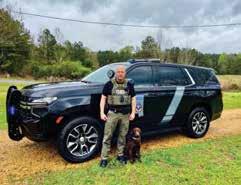
A joint saturation detail conducted on U.S. Route 82 in the Northern Region of Mississippi brought together Mississippi State Troopers, Alabama State Troopers and CTED officers to enhance highway safety through targeted enforcement and the inspection of CMVs.
This high-visibility enforcement initiative focused on strategic zones to deter unsafe driving behaviors and ensure CMV compliance with safety regulations. The effort was a testament to the value of collaboration, with Maj. Justin Alsup and Maj. Scott Henley of the Mississippi Highway Patrol providing exceptional leadership in planning, coordinating and implementing this multi-agency operation. Their efforts not only increased road safety but also fostered a sense of camaraderie and teamwork, effectively leveraging the knowledge and manpower of all agencies involved. n

CTED partnered with the U.S. Park Rangers to produce a commercial encouraging CMVs to stay off the Natchez Trace Parkway. Commercial vehicles, including semi-trucks, are prohibited on the Natchez Trace Parkway because the roadway is not designed to accommodate the weight or width of a semi-truck. This initiative, featuring CTED Sgt. Branson Tennyson, highlights the importance of multi-agency cooperation in protecting designated roadways, preserving natural resources and ensuring public safety. By working together, agencies like CTED and the U.S. Park Rangers reinforce a shared commitment to maintaining the integrity of Mississippi's scenic and historical routes. n
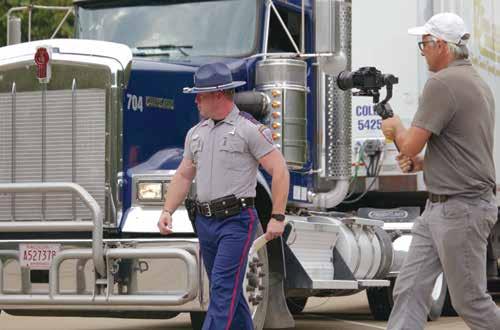
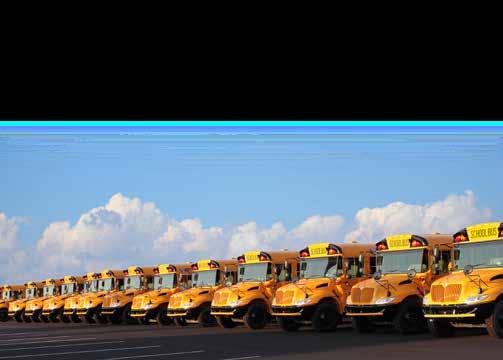
CTED and MHP have launched new billboards near high-crash corridors across the state as part of its public education and outreach initiatives. These billboards serve as a critical reminder to the public to drive safely, reinforcing CTED's commitment to reducing crashes and saving lives on Mississippi’s roads. By strategically placing these messages in areas prone to crashes, CTED aims to raise awareness and encourage responsible driving behavior.
Public trust is the foundation of effective enforcement and education efforts. Upholding professionalism, fairness and transparency in all interactions strengthens the relationship between CTED and the communities it serves, ensuring that safety campaigns resonate and positively impact public behavior. n

MHP Staff Sgt. Bryan McGee and CTED Sgt. Cody Crum recently partnered to educate bus drivers at the Corinth School District on enhancing safety practices while operating their vehicles.
With a shared commitment to protecting Mississippi's most precious cargo – our children –the officers provided valuable insights on defensive driving, proper vehicle inspections and strategies to mitigate risks on the road. This collaborative effort emphasized the importance of vigilance and adherence to safety regulations to ensure every school bus journey remains as secure as possible. n
Continued from page 15
Master Sgt. Dustin McGee has demonstrated exceptional dedication and leadership as CTED's statewide human trafficking investigator. He has organized and conducted vital human trafficking training sessions for CTED officers, equipping them with the knowledge and skills to identify and combat this heinous crime.
On April 24, 2024, CTED held TAT (formerly Truckers Against Trafficking) training at the Mississippi Agriculture and Forestry Museum in Jackson, Mississippi. The following week, CTED Ofc. David Twiner rescued a 16-year-old girl from human trafficking, utilizing the critical skills and knowledge gained during this training. The victim was turned over to the Mississippi Department of Child Protection Services and the Office on Trafficking in Persons.
This crucial training session empowered officers with the knowledge and tools to identify and combat human trafficking within the trucking industry. By partnering with TAT, CTED is taking proactive steps to ensure the safety and security of communities. CTED is committed to supporting initiatives that protect the vulnerable and uphold the integrity of Mississippi highways. n
On Sept. 23, 2024, CTED, in partnership with the Texas Department of Public Safety (TXDPS), recently hosted Interdiction for the Protection of Children (IPC) training. This free two-day course is designed to equip frontline officers and investigators with the skills needed to identify and protect children who may be missing, exploited or at risk of harm. n

Each of the following individuals has set an incredible example for all of us, and we are so proud to have them on our team.
Congratulations to the following individuals who were promoted:
• Maj. Scott Henley – Promoted to deputy director of CTED
• Capt. Ezra Gunn – Promoted to director of motor carrier Troop U
• Lt. Blake Hedrick – Promoted to lieutenant of CTED Troop H
• Master Sgt. Dustin McGee – Promoted to statewide human trafficking investigator
• Master Sgt. Victor McCarty – Recognized for his role in CTED Public Affairs
Congratulations to the following 2024 CTED award recipients:
• Cpl. Shartavia Coleman
• Sgt. 1st Class Bennie Hall
• Sgt. Jaclyn Pendleton
• Staff Sgt. Taurence Isom
• Sgt. Cody Crum
• Sgt. Adam Hall
• Sgt. 1st Class Keith Earnest
• Sgt. Branson Tennyson
• Sgt. Phillip Brown
• Staff Sgt. Justin Thomas
• Cpl. Ethan Shrewsbury
• Sgt. Christopher Arthur
• Staff Sgt. James Evans
• Cpl. Trey Mixon
• Sgt. Randall Jones
• Staff Sgt. Bradley Andrew
• Staff Sgt. Vincent Stringer
• Cpl. Glenn Wolf
• Cpl. Christian Benson
• Staff Sgt. James McDeavitt
• Sgt. 1st Class David Guthre
• Ofc. William Twiner
• Cpl. Bryan Summers
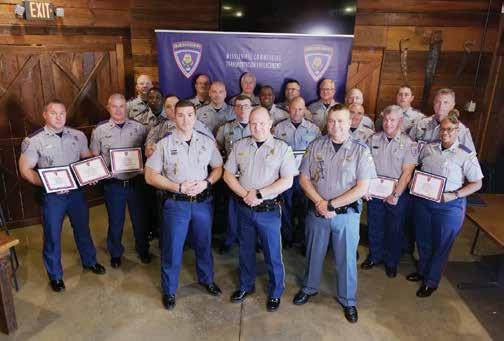
By Monica Greiss, Commercial Vehicle Enforcement Section, North Carolina State Highway Patrol, North Carolina Department of Public Safety
In 2024, the North Carolina State Highway Patrol (NCSHP) participated in SafeDRIVE. SafeDRIVE (Distracted-Reckless-ImpairedVisibility-Enforcement) is a high visibility, multi-state traffic enforcement effort on interstate corridors from the entire east coast and west to Oklahoma and Texas. It is designed to eliminate traffic fatalities by reducing crashes involving large trucks, buses and passenger vehicles.
NCSHP participated in SafeDRIVE during select periods throughout 2024. It partnered with the South Carolina State Transport Police, Georgia Department of Public Safety Motor Carrier Compliance Division, Florida Highway Patrol and other Region II partners, as well as the Federal Motor Carrier Safety Administration. SafeDRIVE is a blitz project that provides high-visibility enforcement with the primary goal of changing unsafe driver behavior, reducing collisions and saving lives.
NCSHP completed 2,288 commercial motor vehicle (CMV) inspections. Of those, 190 vehicles and 104 drivers were placed out of service (OOS). The combined efforts of Region II participants included inspecting 35,039 CMVs. Of these, 4,693 vehicles and 2,216 drivers were placed OOS. n

In December 2024, the Interdiction for the Protection of Children (IPC) Human Trafficking Trainers taught at the Samarcand Training Academy in Moore County, North Carolina. The purpose of this training was to enhance further collaborative efforts to combat human trafficking. The trainers included Sgt. M. C. Nales II, Tpr. C. A. Allen, Tpr. S. D. Kendall II, Tpr. K. L. Denning and Lieutenant J. B. Davis. Representatives from numerous agencies attended this training, including Tpr. A. N. Signs, a member of the NCSHP Commercial Vehicle Enforcement (CVE) Section.
According to the Texas Department of Public Safety (TXDPS) website, “In 2006, TXDPS determined a need to train front-line officers to recognize indicators that a child may be a victim, at-risk of victimization or missing.” In response, TXDPS developed the Interdiction for the Protection of Children program.
IPC uses a multidisciplinary approach to train law enforcement, prosecutors, criminal analysts, child protective services, victim services and child advocacy center professionals collectively. The IPC training team works with local, state, federal, tribal, U.S. territory and international partners to provide classes and educate others on how to intervene when a child is in danger. Documented results prove IPC enhances an officer's ability to identify victims of exploitation, missing children, technology-facilitated crimes against children, high-risk threats against children and registered sex offender violations.
Agencies across the state, throughout the U.S. and worldwide attribute countless child rescues to the IPC program. Additionally, the training has led to investigations for child abduction, human trafficking, possession of child sexual abuse material and child sexual assault. Beyond the rescues and investigations, IPC has prompted policy change within agencies, influenced state and federal legislation, and has been published as part of formal research to improve techniques to protect children.
Through the continued support of many government and non-government partners, IPC continues to provide invaluable, life-saving lessons, embracing and advocating the proactive message: "Stop Waiting for Children to Ask for Your Help." n
Continued on next page

Continued from page 17
On Dec. 12, 2024, NCSHP CVE Sgt. M. G. Conley conducted CMV post-crash investigation awareness training at the Raleigh (North Carolina) Police Department (PD) training facility and driving track.
Participants included NCSHP command staff members and the following North Carolina jurisdictions: Fuquay-Varina PD, Morrisville PD, Raleigh PD, Wake Forest PD, Wake County District Attorney’s Office, Rolesville PD, Apex PD, Holly Springs PD, Cary PD, Garner PD and the Raleigh-Durham International Airport PD.
As the lead agency for CMV inspections, Sgt. Conley provided the history and the foundation of the CMV Post-Crash Investigation Program. He also explained the purpose of completing a CMV post-crash investigation. Sgt. Conley walked participants through how a post-crash investigation is completed. Attendees were provided resources to assist local agencies if a CMV post-crash investigation is needed. They were also given the opportunity to see and walk through a fully equipped post-crash investigation trailer.
During this training, NCSHP Tpr. C. S. Baker provided a presentation explaining the North American Standard Level I Inspection procedure. Participants were invited to watch a complete practical demonstration of the 37step inspection provided by Tpr. Baker.
Attendees provided positive feedback and requested that this presentation be conducted as CMV awareness training. Wake Forest (North Carolina) PD Ofc. M. N. Jones said, “It was nothing less than a privilege to attend the Regional Recon Day held in Raleigh. After working towards becoming a traffic reconstructionist, at the regional day, I was able to learn valuable information that was not only new to me but also can be used every day on the road as a traffic officer. Even for those who may not be a part of a traffic unit, I recommend this training as it serves as a wealth of information that can ultimately save lives. I particularly enjoyed the hands-on examples and the emphasis on the seriousness of enforcing the federal and state regulations.
"When we think about the number of fatalities we see involving CMVs, it is clear that such enforcement is the very least we can do to make our roads safer and minimize these – quite often senseless – tragedies. NCSHP provided many resources and references that I am looking forward to using in the future as I continue my career in law enforcement. The hospitality and knowledge shared at the event was greatly appreciated, and I look forward to attending again.” n

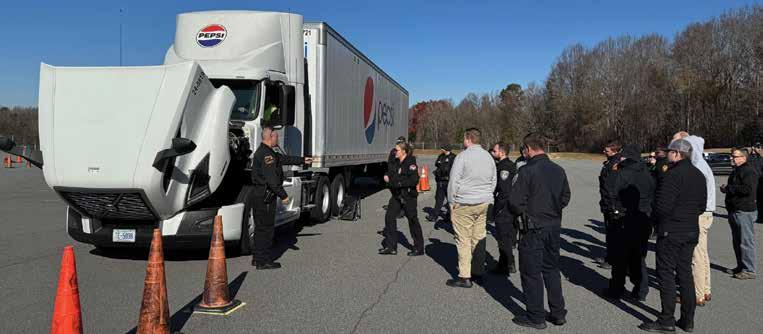
Tpr. Baker leads a Level I Inspection demonstration.
By Lt. Shawn D. Gobble, Motor Carrier Safety Unit, Virginia State Police
The Virginia Tech Transportation Institute (VTTI) is tasked with finding solutions to the greatest transportation challenges facing our nation. The VTTI staff are truly dedicated to saving lives, and the Virginia State Police have partnered with VTTI to focus their educational efforts on new teen drivers across Virginia. Working closely with VTTI staff, Virginia state troopers assist with presentations at high schools, focusing primarily on driving safely around commercial motor vehicles (CMV). Armed with this knowledge, teen drivers have a greater understanding of the capabilities and limitations of large CMVs traveling on the roadways.
VTTI’s Sharing the Road with Trucks outreach program currently visits high schools throughout Virginia, as well as 13 other states across the U.S., to teach teen drivers five key strategies to interact safely with large trucks when encountered on our roadways. As part of the program, Virginia State Police Motor Carrier Unit troopers emphasize the following rules for new teen drivers:
1. Don't hang out in the no-zones.
2. Properly pass trucks.
3. Don't cut it short.
4. Don't get squeezed.
5. Maintain a safe following distance.
The Virginia State Police has partnered with VTTI to send troopers to each event to provide attendees with the law enforcement perspective of traffic safety. This includes how troopers ensure CMVs are safe on our roadways, the penalties for various infractions, including cell phone use and reckless driving, and what to expect at a traffic stop. Ultimately, it gives attendees a positive interaction with law enforcement.
The program currently makes about 75 Virginia high school visits per year and is continuing to grow. It is in its seventh year and has reached nearly 56,000 teen drivers across 14 states. Over the past three years, the outreach program has also participated in community events (state fairs, festivals, parades, corporate
events, etc.), as this information applies to drivers of all ages.
Crash data collected by the Virginia Department of Motor Vehicles from crashes reported by the Virginia State Police and other law enforcement agencies across the state tell a similar story: new teen drivers have a higher-than-average chance of becoming involved in a serious motor vehicle crash. The goal of the Virginia State Police Safety Division is to reduce those odds by providing information to prepare teen drivers to become better defensive drivers. This will assist in making better decisions, especially while driving around CMVs on interstate highways in the Commonwealth.
The Virginia State Police Safety Division is committed to the agency's core mission of promoting highway safety by taking a proactive approach. That starts with education and outreach programs, not only to our teen drivers but also by providing support and educational opportunities to motor carriers and CMV drivers across the Commonwealth of Virginia. n
From Nov. 18-22, 2024, the Virginia State Police conducted an intermodal inspection project at four Port of Virginia facilities: Virginia International Gateway Terminal, Monitor Merrimac Memorial Bridge, Norfolk International Terminal and Pinners Point Container Yard.

The Virginia State Police cruiser and the USS Wisconsin.
Nineteen motor carrier troopers and three motor carrier sergeants were assigned the task of conducting motor carrier roadside inspections at the Port of Virginia facilities. As a result of their efforts, 753 roadside inspections were conducted on intermodal carriers, 49 driver deficiencies were cited and 13 unsafe drivers were placed out of service.
Additionally, 1,298 safety violations were cited, resulting in 143 intermodal carriers being removed from Virginia’s highways.
During the inspection project, inspectors presented information for human trafficking awareness during their driver interviews. n
Continued on next page
Continued from page 19
In 2024, the Virginia State Police Motor Carrier Safety Unit doubled down on its cadre of certified instructors as demands for training continued to increase. Following the retirement of several long-time instructors, the Virginia State Police found itself in a difficult position meeting the training requirements necessary as the lead agency in the state. Safety Division Commander Capt. Sean L. Stewart recognized the need for additional instructors to meet this demand. With the upcoming motor carrier inservice training scheduled for early this year, Capt. Stewart wasted no time recruiting and training three of the most experienced and qualified candidates from within the unit.
Like most agencies across the nation, the Virginia State Police is looking at ways to utilize current manpower more effectively. By taking advantage of certified instructors from within the agency, the Virginia State Police becomes more self-sufficient while


reducing travel expenses necessary to maintain the certification. Adding three highly qualified and experienced instructors will allow more flexibility in training schedules by reducing the number of days troopers are away from their duty posts and focusing more manhours on the core motor carrier safety mission of inspecting commercial motor vehicles.
• Master Tpr. Joseph E. Ferland, a 28-year veteran of the Virginia State Police, was selected as a North American Standard (NAS) Part A instructor and completed his training in January in Nashville, Tennessee. Master Tpr. Ferland has over 25 years of experience with the agency and has been a certified inspector since 1999.
• Master Tpr. Joseph K. Jessee is a 23-year veteran of the Virginia State Police and was selected as a General Hazardous Materials Inspection instructor. Master Tpr. Jessee has been a certified inspector since 2012 and

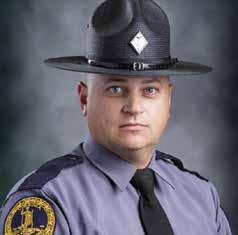
brings a wealth of knowledge and experience related to hazmat inspections to the unit.
• Senior Tpr. John E. Hardy II is a 19-year veteran of the Virginia State Police and was selected as a NAS Part B instructor. Senior Tpr. Hardy has more than five years of experience in the unit and has been a certified inspector since 2019.
They will join the agency's current instructors, including Master Tpr. Derek A. Young, Master Tpr. Jeremy T. Melvin and Master Tpr. Benjamin S. Coates.
With the addition of three new certified instructors and the expertise they bring to the unit, the Virginia State Police Motor Carrier Safety Unit will be better equipped to meet training demands and provide the highestquality training possible in the future. n

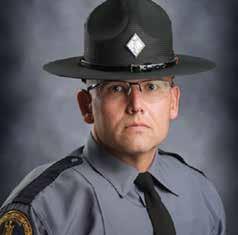
By Capt. Ron Galaviz, Chief Public Information Officer, Indiana State Police
The superintendent of the Indiana State Police (ISP), Douglas G. Carter, recently recognized Maj. Jon E. Smithers for achieving 30 years of service to ISP and the citizens of Indiana.
Maj. Smithers, an Indianapolis, Indiana native, is a 1984 graduate of Southport High School. In 1988, he earned his bachelor’s degree in marketing from Ball State University. On Dec. 4, 1994, he graduated from the 51st Indiana State Police Recruit Academy and was appointed as a trooper assigned to the Indiana State Police post in Indianapolis, where he served for 19 years. In 2000, he was promoted to the rank of sergeant at the Indianapolis post and served as a district squad leader until becoming the assistant district commander in 2008 and the district commander in 2011.
In 2013, Maj. Smithers was promoted to captain and transferred to the ISP Commercial Vehicle Enforcement Division as assistant division commander. He served in that capacity until 2017 when he was promoted to major, where he currently serves as the ISP Commercial Vehicle Enforcement Division commander.
In addition to his ISP duties, Maj. Smithers is an active member of CVSA’s leadership team. He currently serves on the Reauthorization Task Force and chairs the Policy and Regulatory Affairs Committee. He has also served as the committee’s secretary and as the vice president and president of Region III.
During his tenure with ISP, Maj. Smithers has been an instructor for first aid/CPR and speed timing device operations. He has served as a member, squad leader, assistant platoon leader and platoon leader for ISP’s Central Mobile Field Force and has served as a member of the central hostage-crisis negotiator team, graduating from the FBI’s basic hostage negotiator school in 2006 n


By Sgt. Matt Ramsey, Carrier Enforcement Division, Nebraska State Patrol
Brad Wagner
Many of you attending CVSA conferences may have noticed that a smiling, friendly face has been missing from the Nebraska contingent. That person is Sgt. Brad Wagner, and the reason you haven’t seen him lately is because he retired in October 2024.
Brad started his career with Nebraska in June 1987 and began hazmat inspections in 1989. He attended his first Cooperative Hazardous Materials Enforcement Development (COHMED) Conference in 1994. In 2000, he went through the Instructor Development Course in Seattle, Washington, and thus began his long and industrious teaching career with the Federal Motor Carrier Safety Administration’s National Training Center (NTC) and CVSA. Brad, being Brad, taught more than the minimum number of NTC/CVSA courses per year as an instructor –over 60! He taught for more than 24 years, and that’s a lot of up-and-coming hazmat inspectors under his instruction.
In 2000, shortly after taking over the Nebraska hazardous materials coordinator position, he started attending CVSA conferences, including
COHMED. His numerous accomplishments have received several awards:
• He served around seven years as vice-chair of the Hazardous Materials Committee and an additional seven years as chair.
• In the mid-2010s, he served as chair of the Hazardous Materials Committee and COHMED Committee simultaneously for several years, a feat that only a few people have ever managed.
• In 2016, he received the Law Enforcement Award for Excellence at COHMED, as voted on by industry partners.
• In 2022, at the CVSA fall conference in Rapid City, he received the CVSA Leadership Award.
• Lastly, in 2023, he received the COHMED Chairman Award for Excellence.
He taught his last CVSA class in 2024, just before retiring. Over the years, he’s inspired thousands of students, co-workers and industry partners in the wonderful world of hazardous materials. He never shied away from helping anyone who asked questions about hazmat.
In addition to his NTC/CVSA activities, he was also the clan lab coordinator, Nebraska hazardous materials incident response team coordinator and FIT testing coordinator for many years.
His leadership, mentorship and teaching will be greatly missed. But if you think that since he retired, he let all that hazmat knowledge go to waste, fear not! He’s still teaching hazmat as a private contractor somewhere around the world.
We wish Brad well in his retirement years. n


Nebraska State Patrol hosted a post-crash investigation course Oct. 7-11, 2024, in Kearney, Nebraska. This was the largest class Nebraska has hosted, with 32 officers/troopers from 15 agencies nationwide. The agencies that attended this class included the Alaska Department of Transportation, the Grapevine (Texas) Police Department, Illinois State Patrol, Iowa State Patrol, Kansas Highway Patrol, Kansas City (Missouri) Police Department, Kentucky State Police, Missouri State Highway Patrol, Nebraska State Patrol, New Jersey State Police, New Mexico State Police, South Dakota Highway Patrol, Texas Department of Public Safety, Wisconsin State Patrol and Wyoming Highway Patrol.
Troopers of the Nebraska State Patrol Carrier Enforcement Division provided this 40-hour course. It covered information on how to inspect and investigate commercial motor vehicles (CMV) and drivers that have been involved in crashes. The training included classroom instruction as well as inspecting actual crashed CMVs.
This class would not have been possible without the assistance/contributions from the following: the Nebraska Trucking Association, Kearney Volunteer Fire Department, Kearney Towing, Dowhy Towing, Crete Carriers, Nebraska Attorney General’s Office, Great West Casualty, Coach Masters and Bendix Commercial Vehicle Systems LLC.
One reason students leave the Nebraska postcrash class so prepared for real crashes is that the training scenarios use staged, recently damaged CMVs. This would not be possible without the great working relationship the Nebraska State Patrol has with the Nebraska Trucking Association, local towing companies and local industry partners. Nebraska is very fortunate to have such a great relationship with these groups.
The next Nebraska post-crash class is scheduled for Oct. 6-10. If interested in attending, please reach out to david.ramsey@nebraska.gov. n



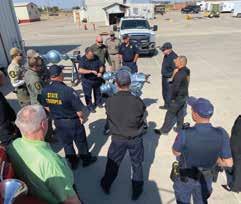
Over Thanksgiving 2024, the California Highway Patrol (CHP) took an innovative approach to keeping roadways safe during its 2024 Maximum Enforcement Period. For the first time, CHP’s Commercial Vehicle Section sent critical safety messages directly to commercial truck drivers through their Electronic Logging Devices (ELDs).
Under federal and state rules, all commercial truck drivers must use ELDs to track hours of service (HOS). These devices help ensure compliance with HOS regulations and promote a safer work environment for drivers. Now, thanks to the Smart Roadways service developed by Drivewyze Inc., CHP can use these devices to provide real-time safety alerts.
Short, geo-targeted messages – no more than 25 characters – notify drivers of roadway hazards, long-term closures, enforcement operations and high-crash areas. These alerts, displayed on a bright yellow background on the driver’s dash-mounted ELD, give drivers advance warning to slow down or prepare for upcoming conditions. California is among a handful of states leveraging this cutting-edge technology to enhance roadway safety.
In addition to delivering safety alerts, CHP is ramping up enforcement efforts to address unsafe driving behaviors that contribute to crashes, such as speeding, following too closely, improper lane changes, reckless driving and distracted driving. Officers are actively patrolling to ensure compliance and educate drivers about traffic safety.
“Our top priority is the safety of everyone traveling this Thanksgiving,” said CHP Commissioner Sean Duryee. “By leveraging innovative tools like electronic logging devices to communicate directly with commercial drivers, we can provide timely alerts and help prevent crashes before they happen.”
CHP remains committed to reducing crashes and keeping all road users safe during one of the busiest travel periods of the year. Commercial drivers are encouraged to stay alert, follow traffic laws and utilize the information provided through their ELDs to make safer driving decisions. The mission of CHP is to provide the highest level of safety, service and security. n
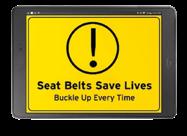
By Ofc. Ty Murray, Mobile Road Enforcement/Hazmat Specialist, California Highway Patrol
The driver of this truck was called into our dispatch center for driving on “flat tires.” Upon being stopped, the driver stated he knew the tires were blown out and was just trying to get to a tire repair shop. He said he did not want to pay for the mobile roadside service to come to him to repair the tires. He was subsequently placed out of service and required to call a mobile repair shop. n


Distraction is described as the loss of concentration in the activity performed by a human being, whether at home or during the workday. When we are an integral part of the road system, as drivers, pedestrians, cyclists or motorcyclists, we need to be focused. Otherwise, distraction can result in substandard performance. It may even become more acute when it causes trauma to the person, such as contusions, traumatic amputations or permanent injuries that can lead to physical and mental incapacity, alter or modify their performance, or, in the worst case, cause a loss of life, which also causes familial grief and economic damages.
In Mexico, during the period from 2001 to 2023, 512,862 road crashes occurred, in which 83,257 people died at the scene of the crash and 456,471 were injured. Of the latter, their physical and mental conditions for returning to daily life activities after the crash are unknown. Unfortunately, identifying a distraction as the cause of a road incident is not easy.
The World Health Organization (WHO) indicates those who use cell phones while driving have a crash risk approximately four times higher than those who do not use cell phones while driving, even if they are using their devices hands-free.

In terms of vehicle driving, distractors can be cognitive, physical, visual and auditory.
Cognitive refers to the time the driver spends occupying their thoughts with a situation other than driving within the road system.
Physical distractions occur when the driver does not hold the steering wheel of the vehicle with both hands for reasons such as using the cell phone (making and receiving calls, texting, manipulating the GPS, etc.), eating, lighting a cigarette, adjusting the air conditioning, applying makeup, combing hair, etc.
Visuals are those caused by eye-catching roadside advertisements, turning your eyes when conversing with vehicle occupants, locating a home, addressing children needing attention and more.
Auditory distractions include listening to the radio at excessive volume, using headphones while driving, conversations with passengers, etc.
In a study of drivers in three Mexican cities –Guadalajara-Zapopan, León and Cuernavaca – more than 10% of drivers used cell phones while driving.
Another study, called “What distracts you at the wheel?”, used qualitative data to identify the habits of drivers when driving a vehicle. This research had a sample of 206 people, and 14.1% of respondents said they always use their cell phones while driving. Furthermore, 37.7% said they sometimes answer a call, and 37.2% sometimes interact with their GPS while driving.
The use of cell phones while driving a motor vehicle causes, among other effects:
• Loss of attention to the road
• A longer reaction time to address the elements of the road, namely, surrounding vehicles, incorporations to the road, and pavement deterioration, among others
• Lack of attention to traffic signal indications
• Other drivers and construction crews are put at risk
• An increased likelihood of crashes and hitand-run incidents
If the driver dials a cell phone number while driving at a speed of 100 kilometers/hour, they will travel 140 meters, which is slightly longer than the length of an American football field, before looking up and pressing the brake pedal.
Similarly, there is the possibility of pedestrians, whose average walking speed is 1.2 meters per second and who will need 10 seconds to cross a 12-meter-wide road, which, in the face of a distracted driver, represents a serious risk. The AAA Foundation for Traffic Safety, in its 2018 study entitled “Crash Risk from Cell Phone Use While Driving: A Cross-Case Analysis of Driving Data,” noted that visual-manual tasks related to cell phone use, especially texting, double the risk of being involved in a crash.
Different federal, state and municipal governmental sectors, as well as civil society itself, make efforts to raise awareness among the population about the importance of avoiding the use of cell phones while driving, as well as through the application of sanctions established in traffic regulations.
Continued on next page
Continued from page 25
The Traffic Regulations for Roads and Bridges of Federal Jurisdiction, published on Nov. 22, 2012, in the Official Gazette of the Federation, states in Article 95:
All drivers of motor vehicles in motion shall:
I. Hold firmly with both hands the steering control and not allow another passenger to take it partially or totally.
IV. Refrain from using communication or entertainment devices that interfere with safe driving.
VI. Avoid holding, carrying, or placing people or animals between their arms or legs.
Drivers who contravene the provisions of this Article shall be fined between 15 and 20 times the daily fine established in this Regulation. For its part, the General Law on Mobility and Road Safety, published on May 17, 2022, indicates in Article 67, Section XIX, that it is up to the federal entities. “[They must] carry out operations to control the use of distractors while driving vehicles, child restraint systems, helmets on motorcyclists, speed control and breathalyzer tests, within the scope of their competence and in accordance with the guidelines established by the National System.”
Recently, the Ministry of Infrastructure, Communications and Transportation (SICT) and the Ministry of Agrarian, Territorial and Urban Development (SEDATU), published the “Manual de Señalización y Dispositivos para el Control del Tránsito en Calles y Carreteras,” or the “Manual of Signaling and Devices for Traffic Control on Streets and Highways,” a complementary document to the Mexican Official Standard NOM-034-SCT2/ SEDATU-2022, “Signaling and Road Devices for Streets and Highways.” This document includes the restrictive sign, “FORBIDDEN USE OF DISTRACTORS,” which indicates to drivers the prohibition of the use of cell phones, other electronic devices, and the consumption of food and beverages, with the aim of eliminating distractions during vehicle operation.
This article focuses on identifying risk factors in the conscious driving of a motor vehicle; however, distractions are also present when driving under the influence of drugs and alcohol, as well as in situations of drowsiness and fatigue. Similarly, the comments have been directed at motor vehicle driving, although they are applicable to all road users.
Coercive measures are embodied in regulatory documents, but there is an urgent need for follow-up actions in the field to make drivers aware that driving a motor vehicle requires total concentration and no distractions.
Cell phones allow immediate verbal communication and text messaging applications. This enables us to instantly reach relatives, friends and work colleagues regardless of physical distance. Additionally, cell phones allow us to immediately contact emergency services for faster response times. Cell phones are obviously a helpful communicative tool which are now integral to society. However, it is urgent that motor vehicle drivers, as well as cyclists and pedestrians, avoid cell phones while driving or moving.
The Global Plan of Action for Road Safety 2021-2030 applies a Safe Systems Approach in which it considers the safe use of roads, indicating that speeding, driving under the influence of drugs or alcohol, distracted driving, and the non-use of seatbelts, child restraint systems and helmets are among the main behaviors contributing to crashes, injuries and fatalities. As a result, the design and operation of the road transport system should take into account these behaviors through a combination of laws, as well as the enforcement of road safety education.
The presence of cell phones in Mexico is increasing. From 2020-2023, it increased by 10 million users, corresponding to 97.2 million cell phone users. Cell phone technology varies, and its use is not limited to phone conversations. It extends to the areas of entertainment, news, music and email, among others. In short, it is an essential element in many activities. It is therefore necessary to raise awareness of the responsible use of this device, especially when driving. Failure to heed these warnings increases the risks of crash, injury and death. n

Mexico's president, Dr. Claudia Sheinbaum Pardo, has appointed new SICT leaders.
Civil engineer Jesús Esteva Medina serves as the head of SICT. Architect Tania Carro Toledo has been appointed as undersecretary of communications and transportation.
Transportation engineer Luis Ruiz Hernández is now the head of the General Directorate of Federal Motor Transport (DGAF).
Civil engineer Jesús Esteva Medina, a graduate of the National Autonomous University of Mexico (UNAM) with a master's degree in structures, has a strong track record in both public and private sectors. Throughout his career, he has contributed to developing significant infrastructure projects, such as constructing bridges, roads and pavement systems. In Mexico City, he played a key role in creating continuous flow intersections and permeable roadways.
During his tenure at UNAM, he led planning and evaluation projects and participated in the National Laboratory of Sustainability Sciences, distinguishing himself as a promoter of innovative infrastructure solutions. He is also an active member of professional organizations such as the Mexican Association of Road Engineering and the Mexican Society of Seismic Engineering.
Esteva Medina has worked in project supervision and explored fields like biomedical engineering, focusing on hypothermia prevention. Additionally, he has taught at UNAM, sharing his knowledge and experience with future generations of engineers.
SICT
Architect Tania Carro Toledo has excelled throughout her career by focusing on the design and management of sustainable infrastructure. With a vision centered on innovation and sustainable urban development, she has participated in highimpact projects such as “The Periférico Oriente Linear Park,” which she coauthored. This project transformed urban spaces in Mexico City, integrating green areas and promoting sustainable mobility.
In her new role, Carro Toledo will oversee the formulation and implementation of policies and strategic projects in communications and transportation, which are essential for Mexico's economic and social development. Her background in architecture and her experience in the urban sector equip her with a comprehensive and innovative approach to addressing the country's infrastructure and mobility challenges.
Transportation engineer Luis Ruiz Hernández brings over 40 years of experience in the transportation sector, both in the public and private spheres.
A graduate of the National Polytechnic Institute with a specialization in Transportation Terminals from UNAM, Ruiz Hernández has held numerous key positions throughout his career, including:
• Undersecretary of transportation at the Ministry of Mobility in Mexico City
• Director general of traffic engineering at the Ministry of Citizen Security in Mexico City
• Secretary of transportation and roads for the government of the Federal District
• Director general of transportation at the Ministry of Transportation and Roads
In the academic field, he has served as general coordinator of transportation projects, professor and president of the Traffic Engineering Academy at the Interdisciplinary Professional Unit of Engineering and Social and Administrative Sciences, sharing his expertise with future generations of engineers.
As head of DGAF, Ruiz Hernández is focused on promoting sustainability, efficiency and innovation in the transportation sector, reaffirming his commitment to continuously improving infrastructure and mobility services in Mexico.
This new leadership team at SICT reflects a renewed approach to addressing challenges and seizing opportunities in infrastructure, communications and transportation – key elements for Mexico’s development. n

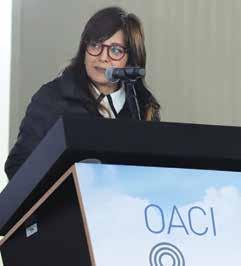

Continued from page 27
On Nov. 29, 2024, the first session of the National Mobility and Road Safety System, titled “Challenges for the Transformation of the Metropolis,” was held as part of the sixth meeting of the National Metropolitan Network. This event, which is highly relevant to mobility and urban planning policies in Mexico, brought together federal and state authorities, as well as representatives of associations and chambers of the transportation sector.
Among the attendees were SICT Undersecretary Tania Carro Toledo, SEDATU Undersecretary Víctor Hugo Hofmann Aguirre, SEDATU General Coordinator of Metropolitan Development and Mobility Álvaro Lomelí Covarrubias, and
Tlaxcalan Ministry of Infrastructure Diego Corona Cremean.
The governor of Tlaxcala, Lorena Cuéllar Cisneros, offered a welcoming message, emphasizing the importance of interinstitutional collaboration to face the challenges that Mexico's large metropolises face in terms of mobility and road safety.
Discussions included strategies to strengthen road infrastructure, improve connectivity between metropolitan areas and ensure the safety of users in various modes of
transportation. The current challenges in implementing public policies that promote sustainable mobility and contribute to reducing the carbon footprint in urban areas were also discussed.
One of the main actions highlighted was the Mobility and Road Safety Module 1.0: Territorial Development and Homologation of Records. This module seeks to share and standardize information at the national level among the different states to improve the efficiency and accuracy of the data used by the competent authorities in vehicle control and mobility management.



Guidelines were agreed upon and created to ensure the correct regulation of state and municipal traffic, guaranteeing the right to mobility of all people. They will serve as a technical guide for adapting policies and instruments related to local transit in accordance with the General Law of Mobility and Road Safety.
Another critical issue was reforming the fourth article of the Mexican Constitution in 2020, which recognizes mobility as a human right. According to Governor Cuellar Cisneros, “Any person in Mexico has the right to mobility in conditions of road safety, accessibility, efficiency, sustainability, quality, inclusion and equality.” This constitutional change marks the beginning of a new era in which mobility is considered an essential right for all citizens, which drives public policies to guarantee this right in every Mexican city.
Including the gender perspective in transportation systems was another relevant topic in the session. The state of Baja California proposed continuing to advance the integration of policies that address specific challenges women face in transportation, such as safety, accessibility and schedules. Women often face situations of insecurity, lack of lighting at stations and schedules poorly adapted to their caregiving responsibilities.
To create more equitable cities, measures such as safe waiting spaces, well-lit routes and more flexible schedules that respond to women's needs must be incorporated. Promoting women's active participation in transportation decision-making is also key to designing fairer and more efficient mobility systems, not only for women but for the entire population.
The extraordinary session of the National Mobility and Road Safety System underscores the importance of inter-institutional cooperation and the adoption of public policies aimed at safer, sustainable and inclusive mobility. With the recognition of mobility as a human right and the implementation of specific strategies, Mexico is taking firm steps toward building more accessible and equitable cities for all its inhabitants. n
During the winter holiday season from Dec. 19, 2024, to Jan. 8, 2025, SICT, through DGAF, conducted a comprehensive inspection program in major passenger terminals across the country. This initiative aimed to ensure passenger transportation services complied with current regulations, prioritizing user safety and service quality.
The inspection program focused on verifying the compliance of passenger terminals with the provisions outlined in Article 42-B of the Federal Motor Carrier Transportation and Auxiliary Services Regulations. Specific aspects of the inspections included:
• Ensuring the presence of essential facilities and equipment as mandated by the regulations
• Confirming the availability of free, hygienic and sanitary restroom services
• Verifying the existence of a public information module to guide passengers effectively
• Ensuring tariffs and destinations were clearly displayed and legible to users
The program’s overarching goal was to enhance passenger service quality while adhering to national standards, reinforcing user trust in the transportation system.
An integral part of the operation was addressing user complaints about service deficiencies by transportation operators. DGAF actively engaged with passengers, investigating reported issues and ensuring corrective actions were taken. This usercentric approach highlighted the commitment of Mexican authorities to uphold passenger rights and improve service standards.
To further enhance road safety, passenger vehicles operating at the terminals were subjected to physical and mechanical inspections. These inspections ensured compliance with the Mexican Official Standard NOM-068-SCT-2-2014, which establishes the minimum safety conditions for vehicles providing passenger transportation services. Key aspects evaluated included mechanical integrity, operational safety features and overall vehicle maintenance.
The winter inspection program underscored the importance of collaborative efforts between federal authorities and transportation operators to provide safe and reliable passenger services. By focusing on both terminal facilities and vehicle safety, SICT demonstrated its commitment to fostering a culture of compliance and prioritizing the well-being of travelers during one of the busiest travel seasons.
This initiative reflects Mexico’s dedication to road safety and aligns with international best practices promoted by organizations such as CVSA. As Mexico continues to strengthen its transportation oversight, these programs contribute significantly to improving safety standards and enhancing the travel experience for millions of passengers. n
Continued on next page
Continued from page 29
The National Chamber of Freight Transportation (CANACAR) held a ceremony to deliver the CANACAR Distinction and the IRU Honor Diploma 2024, an event highlighting the effort and commitment of companies and operators in Mexico's freight transportation sector. This distinction highlights the contributions of companies and professionals to the continuous improvement and professionalization of industry, which is vital for the country's economic development.
During his speech, Ruiz Hernández emphasized that the commitment of the freight transportation sector is key to Mexico's economic development. He acknowledged the industry's ongoing challenges and emphasized that advancements in training and professionalization will enable companies to continue playing an essential role in the national economy.
Ruiz Hernández also stressed the importance of recognizing drivers, stating, "It is an act of social, business and labor justice, as the honorees are literally heroes of the road,
considering that this activity is essential to supply chains."
This year, a total of 326 companies and 4,125 professionals were recognized for their efforts and commitment to strengthening training and best practices within the sector. The CANACAR Distinction was awarded for the ninth time as part of the Transporting the Country, Transporting Mexico program, the goal of which is to promote training, skill development and the implementation of processes that support the professionalization of freight transportation in the country.
During the event, 383 distinctions were awarded to companies that stood out for their policies, programs and actions aimed at improving service quality in the sector. Of these:
• 56 distinctions were granted to companies that achieved the basic level
• 52 distinctions were awarded at the intermediate level
• 48 distinctions were granted at the advanced level
Additionally, recognition was given to companies successfully completing various diploma programs:
• 70 recognitions for the “Financial Education” diploma
• 44 recognitions for the “Freight Transportation Economics” diploma
• 35 recognitions for the "Human Factor: A Key Element in Organizations" diploma
• 30 recognitions for the “Energy Efficiency in Freight Transportation” diploma
• 48 recognitions for the "Technical Assistance Tools for Your Business" diploma
This event highlights the continuous efforts of CANACAR and other entities in the sector to raise standards of quality, safety and efficiency in freight transportation. It also reaffirms the importance of training and education as fundamental pillars for success in this key industry for Mexico's development. n

By Christopher Vinson, Midlothian (Texas) Police Department; CVSA Local Member President
Congratulations to the following CVSA Class II Local Members who retired this past year:
• Jeff Tippet, who retired from the La Porte (Texas) Police Department Commercial Vehicle Unit with 40 years of service
• Paul Ambrose, who retired from the Macomb County (Michigan) Sheriff’s Department Commercial Vehicle Unit with 26 years of service
• Richelle Esquivel, who retired from the Richardson (Texas) Police Department with 26 years of service
Thank you, Jeff, Paul and Richelle, for your commitment to commercial motor vehicle safety. I wish you all a relaxing and prosperous retirement.
Additionally, I am honored and humbled to start my term as the CVSA Class II Local Member president. I have big shoes to fill, maintaining the good work and accomplishments of the great men who’ve held this honor before me. With an evergrowing membership group and a 2024 local membership North American Inspectors Championship win, I look for local members across North America to continue getting more active, providing relevance and contribution to the Alliance and industry. Thank you for trusting me with this mission.
With our membership group spreading across all regions throughout North America, I cannot thank the Alliance and Emily Moorhead enough for making this locals section in “Guardian” magazine a reality. This honor will provide a platform to increase awareness of the good works of local members everywhere. With that said, I am calling on all local members to please continue sending content showing the good work we do out there.
Content can be sent to emily.moorhead@cvsa.org at any time for consideration for the next edition of the magazine. As always, we are here to help if you have questions or ideas. n





By Christopher Vinson, Midlothian (Texas) Police Department; CVSA Local Member President

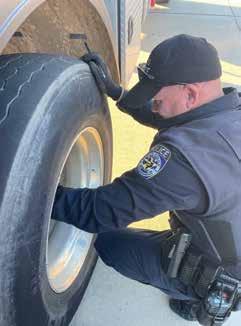

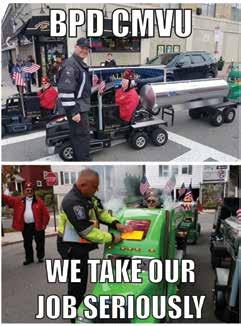

Nov. 25,

During the multi-agency detail, inspectors came together to achieve a total of 82 truck inspections. Thirtyseven vehicles and two drivers were placed out of service, and there was one arrest.

Officers from 13 different Texas local agencies and troopers from the Texas Department of Public Safety came together for a Level I Inspection detail in Midlothian, Texas, in November 2024. Over the course of seven hours, they pulled over trucks from U.S. Highway 287 for random inspections, similar to a pop-up scale house event.
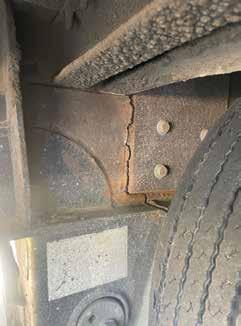
At the multi-agency inspection detail in Midlothian, Texas, inspectors discovered this cracked frame, which was on a trailer loaded with flattened cars with a total of 75,000 pounds gross weight.
By Christopher Vinson, Midlothian (Texas) Police Department; CVSA Local Member President
Ofc. Alexis Crockett of the Garland (Texas) Police Department was presented with the Excellence Award in Community Engagement at the Dallas–Fort Worth Council of Safety Professionals meeting in December 2024.
Safety council members Steve Wilhelms and Kenny Ray presented Ofc. Crockett with the award, coming together to say, “Officer Crockett is a commercial vehicle enforcement officer whose daily goal is to ensure the safety and integrity of commercial motor vehicles traveling on the roadways and through the city of Garland. For the past three years, he has also played a considerable role in the National Truck Driving Championship in Garland.” n

By Michael Thigpen, Deputy Sheriff, Commercial Vehicle Enforcement, Collin County (Texas) Sheriff’s Office
CVSA Class II Local Members Deputy Stephen Diaz and Deputy Michael Thigpen of the Collin County (Texas) Sheriff’s Office Commercial Vehicle Enforcement Unit participated in a Q&A session following the SRS Distribution Driver Championship held in December 2024 at its headquarters in McKinney, Texas.
This yearly competition, organized by SRS Distribution, included 39 of its top-rated drivers from across the U.S. Such events benefit continued safety in commercial transportation. We applaud SRS Distribution and its partners for taking safety and performance so seriously and thank them for inviting us to participate in a small portion of this event. n

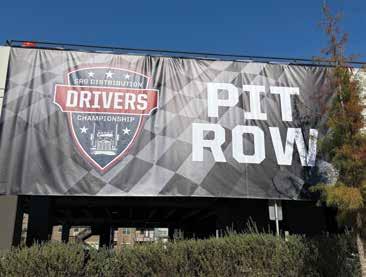
By David Driskill, Senior Police Officer, Commercial Vehicle Enforcement, Austin (Texas) Police Department

On Jan. 16, the Austin (Texas) Police Department responded to a rollover collision involving a commercial motor vehicle (CMV). Multiple witnesses indicated they noticed a dump truck stopped in traffic on the service road of I-35 southbound when the dump bed began to rise. They watched the CMV turn at an intersection and subsequently strike the overhead traffic signal light with the raised bed. The impact with the signal light resulted in the CMV overturning and coming to rest on its side. The signal light was significantly damaged due to the collision, rendering it inoperable. The driver was able to escape from the CMV without injury.
I coordinated with officers on the scene to obtain photographs of the crash prior to my arrival. The Austin Police Department Commercial Vehicle Enforcement Unit has a robust working relationship with several towing companies in the city, which are delegated the responsibility of mitigating large-scale CMV crashes.
Once the towing company was assigned, I called the driver to discuss the recovery with him. It was evident additional equipment would be needed, so arrangements were made immediately rather than waiting for his arrival and assessment. The towing company mitigated the scene with two 50-ton wreckers and a service truck carrying a skid steer with a sweeper. What is typically a multi-hour response was reduced to approximately 45 minutes due to our existing relationship with the towing company and our ability to coordinate the response before the first wrecker arrived on scene.
No mechanical defects contributed to the collision, and it was evident that the cause was driver inattention. During my interview with the driver, I noticed that he smelled of alcohol, and once the dump truck was upright again, an open container of beer was found in its cab.
The driver submitted to field sobriety testing and a preliminary breath test for alcohol content. Although the driver was not legally
intoxicated, the driver had a positive result for alcohol in his system and was placed out of service for possession of alcohol in a CMV and having a detectable amount of alcohol in his system while on duty.
In total, a major highway artery was closed for approximately seven hours while the crash was cleared and the signal light was repaired. Although the recovery by the towing company was relatively minor and straightforward, this incident helped to highlight the importance of a strong relationship between law enforcement and towing companies. Without this relationship, we wouldn’t have been able to manage the aftermath of this CMV crash scene efficiently. After a crash, our goals are to clear the roadway, return the flow of traffic to normal, reduce congestion and reduce the odds of any secondary collisions. Engaging with your local tow companies and establishing these relationships before these incidents occur may pay dividends when the time comes to handle these scenes. n
By Sgt. Doug Floyd, Commercial Vehicle Enforcement, Austin (Texas) Police Department
CVSA Class II Local Members in Austin, Texas, hosted a bus inspection detail on Oct. 17, 2024, in coordination with the Formula 1 Pirelli United States Grand Prix, which took place Oct. 18-20, 2024.
Inspectors conducted 144 inspections and found 155 violations, resulting in 21 buses being placed out of service for major equipment violations. Two drivers were also placed out of service – one for possession of alcohol while operating the bus and admission to driving within 24 hours of consuming alcohol. He was placed out of service for 24 hours. Inspectors issued 59 CVSA decals to buses with no violations.
This was a multi-agency detail with support from local, state and federal partners. Inspecting this high number of buses wouldn’t have been possible without the help of the following agencies: Austin (Texas) Police Department (PD), Texas Department of Public Safety, Brownsville (Texas) PD, Cedar Park (Texas) PD, Travis County (Texas) PD and federal inspectors from the Federal Motor Carrier Safety Administration. n


During the multi-agency Formula 1 bus inspection event, inspectors conducted 144 inspections (placing 21 buses and two drivers out of service) and issued 59 CVSA decals.

Ensuring roadside safety during commercial motor vehicle (CMV) inspections is a critical responsibility of enforcement officers/inspectors. Roadside environments are inherently dangerous, and the risks are amplified by variables such as inclement weather, low visibility, distracted drivers and the potential dangers of hazardous materials/dangerous goods (HM/DG). The right combination of training, gear and situational awareness is essential to protecting inspectors/officers while they work to uphold CMV regulations. By ensuring their safety, officers/inspectors can also better protect CMV drivers and the general motoring public.
Inspectors/officers must follow their jurisdiction’s safety rules, requirements and guidance. This article offers supplemental roadside inspection safety tips, highlights options for protective gear and equipment for CMV inspectors/officers, and discusses the unique challenges of inspecting trucks carrying HM/DG loads.
Continued on next page
Roadside inspections place inspectors near high-speed traffic. According to the National Law Enforcement Officers Memorial Fund, over the past decade, 150 officers were killed when they were struck by a vehicle. Common hazards include:
Proximity to Traffic: Vehicles pass at high speeds, sometimes within feet of an inspection site.
Distracted Drivers: Motorists are distracted or fail to notice officers near the road.
Environmental Conditions: Poor lighting, adverse weather and uneven terrain can create additional risks.
Vehicle-Specific Dangers: CMVs can have blind spots, faulty equipment or improperly secured cargo that could pose threats during an inspection.
Hazmat-Specific Hazards: HM/DG loads may introduce risks of spills, leaks or exposure to toxic substances.
Understanding these risks emphasizes the need for robust safety measures and properly equipped officers and inspectors.

Equipping inspectors with proper protective gear and equipment can significantly mitigate risks. Officers must ensure they are following their agency’s uniform and safety equipment requirements; however, here are some examples of gear and equipment that – if permitted by the department and approved by supervisory personnel – may be helpful in protecting inspectors:
• Cut-Resistant Gloves: These are ideal for handling sharp objects, such as damaged parts or broken cargo straps.
• Chemical-Resistant Gloves: When an officer is inspecting vehicles carrying HM/DG loads, these prevent skin exposure to potentially hazardous or dangerous substances.
• Slip-Resistant Boots: Boots with slipresistant soles provide stability on wet or uneven surfaces.
• Steel-Toed Boots: These offer added protection against heavy objects, such as falling tools or unsecured cargo. If possible, choose boots that are slipresistant and have steel toes.
• Hard Hats and Bump Caps: Hard hats and bump caps protect inspectors from overhead hazards, particularly during inspections at loading docks or near improperly secured cargo.
• Earplugs or Earmuffs: Hearing protection is essential to prevent longterm damage when inspecting vehicles in areas with high noise levels, such as highways or near operating CMV engines. According to a systematic review study, more than one-third of police officers experience noise-induced hearing loss.
• Safety Glasses: These protect against flying debris, dust or fluids during inspections, particularly under a truck or near moving parts. Regular prescription eyeglasses will not suffice, but prescription safety glasses are available.
• Flashlights or Headlamps: A durable, waterproof flashlight or headlamp ensures clear visibility during night inspections or when working in dark areas under vehicles. It never hurts to have a backup light source, too.
• ANSI/ISEA 107-Compliant Vests: Highvisibility (hi-vis) safety vests, shirts and/or jackets (that meet ANSI Class 2 or 3 standards) enhance visibility during daytime and nighttime operations.
• Reflective Accessories: Hi-vis gloves, armbands and hats can further improve visibility, particularly in low-light conditions.
• Typically made from a durable material, such as cotton or polyester, coveralls are designed to fit loosely so they do not restrict movement. Depending on their specifications, coveralls may provide protection from chemicals, dirt and debris, fire, cuts and abrasions, and weather conditions.
• Masks or Respirators: In situations involving poor air quality, chemical spills or HM/DG, officers/inspectors should have access to N95 masks or higher-grade respirators.
1. Avoid conducting a North American Standard Inspection by the side of a road. Crawling under the vehicle is dangerous enough without the threat of passing traffic.
2. Be aware that many trucks carry HM/DG. Never touch liquids or breathe fumes unless you are certain of the source. If you suspect a problem, contact local experts immediately.
3. Make sure the inspection site is level and able to support the weight of the vehicle.
4. Do not go underneath a vehicle while the engine is running.
5. Use chock blocks to prevent the vehicle from moving. Place one in front of and one behind the axle tires or between the axles.
6. Have the driver place the transmission in neutral and release all brakes.
7. Use extreme caution when inspecting between tandem axles, when checking tires, inside wheels and suspension components (particularly air spring suspension systems), or between the front fender well and front tire when checking steering components.
8. Always inform the driver when you are going under the vehicle.
9. Always enter and exit the vehicle undercarriage in view of the driver. However, if you choose to conduct this inspection by the side of a road, it is best to exit the vehicle undercarriage on the curbside.
10. When under the vehicle, try to remain in a position parallel with the frame rail. Never position your body directly in front of or behind a tire.
11. Never position your body directly behind the spring brake chamber. When the spring brake is compressed (parking/emergency brakes released), the potential for explosion of the chamber exists. This potential is increased when there is any corrosion of the chamber. Never attempt to remove any clamps or bolts from these chambers.
12. Never position your body directly behind/beside a component that is defective to the extent that it poses a hazard to the inspector or public, including, but not limited to, non-manufactured holes in the spring brake chamber, broken lock rings, severely damaged/bulging tires, etc. If a violation poses a hazard to the inspector or the public, the inspection should be limited to an applicable inspection level.
13. If inspecting electric-drive CMVs:
• Do not touch or come into contact with any exposed copper wires from an orange cable or conduit, or inside compartments marked “High Voltage” or labeled with a yellow triangle bearing a black thunderbolt.
• Do not attempt to open any compartment marked “High Voltage” or labeled with a yellow triangle bearing a black thunderbolt.
• Do not poke fingers, screwdrivers or other tools into any holes, cracks, crevices or openings in compartments marked “High Voltage” or labeled with a yellow triangle bearing a black thunderbolt.
• Do not touch any liquid that may be exuding from a battery (also called rechargeable energy storage system) regardless of low or high voltage.
• Do not inspect a vehicle that has a “High-voltage Fault” or “Stop Hybrid” or “Stop System” red light illuminated on the dashboard that could indicate loss of electrical isolation in the high-voltage system (these vehicles should not be operated).
Please note: The CVSA Operations Manual is subject to change. Refer to the Operations Manual in the CVSA member portal (portal.cvsa.org) for the most up-to-date version of all operational policies.

Protective gear is only part of the equation. Following proven safety practices is equally essential for reducing risks during roadside inspections. CVSA Operational Policy 5 –Inspection/CVSA Decal outlines best practices for roadside inspection safety, and these instructions should be followed as closely as possible during each inspection. A portion of CVSA Operational Policy 5 is included at left. You may access the CVSA Operations Manual via your member portal at portal.cvsa.org.
Inspections of trucks carrying HM/DG present unique challenges. HM/DG loads often involve flammable, corrosive, toxic or explosive materials. Inspectors must be trained to carefully handle these situations, have the proper equipment and know how to safely use it.
The first line of HM/DG safety is awareness. All inspectors should, at minimum, have HM/DG awareness training. This training enables them to recognize clues that HM/DG may be present, including markings, labels, placards, types of packaging and vehicle types.
Basic hazard materials awareness training components are included in CVSA's General Hazardous Materials, Cargo Tank Inspection and Other Bulk Packaging inspection courses. Inspectors interested in becoming hazmat certified should look for a General Hazardous Materials Inspection Course at www.cvsa.org/ training-type/general-hm. Additionally, live virtual Lithium Battery Inspection training courses are available for hazmat-certified inspectors at www.cvsa.org/training-type/ continuing-education. CVSA also offers HM/ DG-related webinars throughout the year. Visit www.cvsa.org/webinars to check out the schedule of upcoming webinars.
CVSA’s inspection bulletins provide additional important information to augment the existing inspection program. Visit www.cvsa.org/ inspections/inspection-bulletins to access all current HM/DG inspection bulletins.
Bill Reese CVSA Director of Hazardous Materials Programs

I was completing a roadside inspection on a load of sulfuric acid. After I stopped the vehicle, as I walked by the back of the cargo tank to approach the driver, I noticed the pump was leaking, and there was sulfuric acid in the drip pan below the pump.
There was not a lot of acid, but the pump was actively dripping. I was talking with the driver, and a few minutes later, I felt burning on my arm. I looked closely at my forearm and could see three tiny pin-sized specks of sulfuric acid. It must have splashed on me as I walked by to look at the leaking pump.
I used some emergency eye wash I had in my patrol truck to rinse off my forearm. All’s well that ends well, but remember, it’s easy to get exposed accidentally. This is a good example of why you should always be alert and on the lookout for leaking hazmat.
Additional educational opportunities are available on CVSA Learning (learning.cvsa.org) under the Hazardous Materials/Dangerous Goods category. HM/DG archived webinars, on-demand training courses, one-minute Inspection Bitz training videos, standard short- and long-form training videos, and Quick Fix video tutorials are all various forms of continuing education that inspectors may access at any time on CVSA Learning.
All inspectors/officers should continually be on the lookout for leaks. An HM/DG leak could come from the cargo or the fuel source for the CMV – so there is still a risk of HM/DG leaks even if the truck is not hauling an HM/DG load. If you see anything dripping from a CMV or it is raining, do not get under the vehicle. HM/DG may be mixing with the rainwater, so avoid the situation.
If a leak is found, stop the inspection and follow agency policy and procedures for proper notification, response and clean up. The Emergency Response Guide will provide guidance for spills and leaks, as well as evacuation and isolation distances.
With the push for green energy, alternative fuels are used more often. These include hydrogen, natural gas and lithium batteries, each with unique characteristics and hazards that the inspector needs to be aware of.
Personal protective clothing is vital. Every inspector should use their jurisdiction’s approved basic safety equipment, including
protective footwear, eyewear and head protection. Additionally, protective gloves should be worn. These gloves provide some chemical protection and should be replaced frequently. If you suspect your gloves have been exposed to HM/DG, properly dispose of them and replace them immediately. Signs that your skin has been exposed to HM/DG vary significantly depending on the material, but they generally include itching, red skin, pain at the point of contact, a burning sensation on the surface of the skin and obvious damage to the skin. Keep in mind that some HM/DG may be absorbed through the skin without damaging it. When in doubt, follow the exposure protocol.
Before taking action, pause and run through your safety protocols. It’s smart and safe to take your time.
“Remember, as an inspector, your safety is always number one,” said CVSA Director of Hazardous Materials Programs Bill Reese. “The only senses you should be using to detect hazardous materials are your eyes and ears; however, you should always be alert for chemical odors.”
When you get home, remove your uniform – especially your footwear – in a garage or other location outside your living space, if possible. Your footwear is the number one cause of inadvertently bringing HM/DG home. If you have small children or pets, you may accidentally expose them. If you launder your inspection uniforms at home, do so separately from your other clothing.

Interacting with drivers during roadside inspections may sometimes lead to tension, particularly if the driver is frustrated or irate because they are losing time and money while off the road. De-escalation is a critical skill for CMV inspectors because maintaining a calm and professional demeanor not only ensures safety but also fosters mutual respect and cooperation. Inspectors/officers should utilize their department’s de-escalation training and guidance. However, here are some tips that may be helpful.
The first step in de-escalating a tense situation is to remain composed. Avoid responding to anger with anger, as this can intensify the conflict further. Speak in a calm, steady tone and use neutral language to diffuse tension. Remember, drivers may feel stressed due to tight schedules, personal issues or a misunderstanding of regulations. Responding with patience may help defuse their frustration
Frustrated drivers often want to feel heard. Acknowledge their concerns by actively listening and using empathetic statements, such as, “I understand this is frustrating for you,” or “I hear your concerns about your schedule.” Validating their feelings doesn’t mean you agree with their perspective; rather, it shows respect for their situation and helps build rapport.
Keeping the conversation focused on the facts may help shift the interaction away from emotion. Explain the reason for the inspection clearly and concisely, referencing specific regulations or safety protocols as needed. Use non-threatening language, such as, “For your safety and the safety of others, I need to check…” rather than framing the inspection as punitive.
If a driver’s behavior becomes aggressive, it’s essential to set clear, firm boundaries without worsening the situation. For example, you might say, “I need us to keep this conversation respectful so we can address the issue quickly.” Redirect the conversation toward resolving the immediate issue, emphasizing the shared goal of ensuring safety and compliance.
In rare cases where a driver’s behavior becomes threatening or unsafe, prioritize your safety and that of others. If attempts to deescalate fail, call for backup from additional officers as necessary. Avoid engaging further until support arrives, and ensure the situation is managed without putting yourself or the motoring public at unnecessary risk.
Once the issue is resolved, aim to end the interaction on a positive note. Thank the driver for their cooperation and explain the next steps, whether that involves a citation, a warning or simply a conclusion to the inspection. Providing closure helps leave the driver with a sense of resolution and reduces the likelihood of lingering resentment. By using these techniques, inspectors/officers can handle challenging interactions with professionalism and care, ensuring inspections proceed as safely and efficiently as possible while minimizing unnecessary conflict.
Advancements in technology are enhancing roadside safety for enforcement officers. Tools such as portable electronic inspection devices, real-time traffic monitoring systems and automated CMV screening systems are reducing the time inspectors spend in highrisk environments. Future innovations may include wearable tech, such as smart helmets or augmented reality glasses, providing officers with instant access to inspection data and situational alerts.
As the industry evolves, so too must safety strategies. By staying informed and prepared, officers/inspectors not only protect themselves but also set the standard for professionalism and excellence in commercial motor vehicle enforcement.
Safety is the cornerstone of effective roadside inspections. By combining high-quality protective gear and equipment, adherence to jurisdictional requirements and best practices, and ongoing training, CMV inspectors/officers can mitigate the inherent risks of their work and focus on their critical mission: ensuring the safety of commercial motor vehicles, drivers and the public. n
Place the vehicle in park or neutral and set the brakes until told to do otherwise by the inspector.
The inspector will explain hand signals and provide instructions.
Let the inspector know if you can’t hear or understand them.
Make yourself visible and stay in the vehicle. Leave your safety belt on until the inspector makes contact with you.
Do not switch seats with the co-driver.
If any animals are present, secure them and alert the inspector of their presence.
Stay alert throughout the inspection with no distractions. Stay off your phone and focus on the inspector and their instructions.
Always look for the inspector in your mirrors as the inspection is being conducted.
Be courteous and professional.

By Rodolfo Giacoman, Fatigue Specialist, Commercial Vehicle Safety Alliance
When talking with motor carrier representatives about the two key components of a fatigue management program (FMP), I always feel confident they understand when I describe one of them: the fatigue risk management system. They comprehend the processes and controls to identify, assess and counteract risks. But when I address the other component, the safety culture, many times I hit a blind spot.
Culture is defined as a shared set of values, attitudes and behaviors. And changing culture is no trivial task. One reason is that as individuals and as a society, we carry values, attitudes and behaviors, some of which have remained consistent from when we were small children because they have been passed down through generations. They’re ingrained in our minds, our organizations and our leaders. Some of those values, attitudes and behaviors are negative toward individuals or groups based on perceived or actual characteristics that are deemed undesirable or deviate from the norm. These are called stigmas.
Five stigmas in particular can be ingrained in motor carrier culture:
Valuing sleep is often seen as a sign of weakness or inefficiency. Drivers may feel pressured to push through fatigue to meet deadlines, increasing the risk of crashes. They may think or say things like:
"Real drivers don't need much sleep –they can push through fatigue."
"Taking naps during breaks is a sign of weakness or laziness."
"Drivers who complain about being tired just can't handle the job."
"Sleep issues are a personal problem, not a safety concern for the company."
"Reporting fatigue will just get you labeled as unreliable."

Obese drivers are often stigmatized, facing potential discrimination and judgment. This can discourage seeking necessary medical attention and contribute to poor metabolic health outcomes, impacting driving performance. Obesity stigmas include:
"Losing weight will fix everything."
"You just need more willpower." (And, just as harmful, “I just need more willpower.”)
"Bigger drivers must be unhealthy."
"Obese drivers will increase our insurance costs and liability risks."
"Obese drivers are more likely to call in sick and are less productive."
Seeking help for mental health concerns like depression, anxiety or PTSD is often seen as a sign of weakness. The "tough guy" image prevalent in the industry discourages vulnerability and can lead to drivers struggling in silence, increasing the risk of burnout, substance use disorder and unsafe driving behaviors. Regarding mental health, some people may believe:
"Professional drivers don't need therapy."
"If you can't handle the stress, find another job."
"Taking time off for mental health is just an excuse."
"Talking about feelings is a sign of weakness in this industry."
"If a driver admits to depression, they're not fit to be behind the wheel."
Stigmatizing addiction can lead to fear of job loss and reluctance to seek treatment. This can have devastating consequences, including impaired driving, crashes and even fatalities. Common misconceptions about substance use disorder include:
"Everyone uses something to get by on the road."
"A little speed never hurt anyone."
"A few drinks help you unwind and sleep better."
"Substance abuse is a moral failing, not a health issue."
"If they wanted to stop, they would; addiction is a choice."
Reporting safety concerns, such as equipment malfunctions or unsafe driving practices, can be met with resistance or even retaliation. This "blame the victim" mentality discourages proactive safety reporting and creates a culture of fear, hindering efforts to improve safety. You have likely heard someone say at least one of the following:
"If you report every little thing, you'll never get anything done."
"We have a zero-tolerance policy for crashes, no matter what."
"If you admit to making a mistake, you're not cut out for this job."
"We have a reputation for being the safest; don’t jeopardize it by reporting anything."
"If you’re too vocal about safety, you might get labeled as someone who can’t handle the job."
These stigmas create a culture of fear, silence and shame, hindering open communication and proactive safety measures. Moreover, these five stigmas will drive up the following seven operating costs for motor carriers:
Increased crash risk due to fatigue, impaired judgment and increased reaction times. Fear of blame or retaliation can discourage reporting safety issues.
High driver turnover due to driver burnout and dissatisfaction.
Operational inefficiency with diminished focus, energy levels and decision-making, leading to delays, missed deadlines and decreased efficiency.
Increased healthcare costs due to chronic health conditions.
Increased absenteeism because of sick days due to illness or the need for treatment.
Reputational damage making it harder to attract and retain drivers, build strong client relationships, and maintain a positive image in the industry.
Legal and financial risks with noncompliance with hours-of-service regulations, resulting in fines and penalties; discrimination claims, resulting in legal fees and settlements; workers' compensation claims and potential
lawsuits; failed drug tests; violations of safety regulations; and other legal repercussions if negligence is proven in the event of a crash or injury.
Implementing an FMP serves as a powerful tool to address these stigmas and foster a safer, more supportive environment for drivers. Here are the key components of an effective FMP:
• Cultivate a culture where safety is a value (not merely a priority) and drivers feel valued and respected. This involves open communication, active listening and a commitment to driver well-being.
• Provide comprehensive training on fatigue recognition and management techniques.
• Educate drivers on the importance of sleep hygiene and the impact of fatigue on performance.
• Conduct regular training sessions on mental health awareness, substance abuse prevention and metabolically healthy lifestyle choices.
• Foster open communication channels between drivers and management.
• Establish partnerships with industry organizations and healthcare providers to share resources and best practices.
• Implement a system for identifying, assessing and mitigating fatigue risks.
• Utilize predictive modeling, scheduling and routing, proactive programs, and reactive measures to address fatiguerelated concerns.
• Implement sound scheduling practices that prioritize driver rest and minimize fatigue.
• Offer access to sleep disorder programs and use fatigue detection technologies.
• Conduct regular risk assessments to identify and address potential hazards.
• Develop and implement effective countermeasures to mitigate identified risks.
• Continuously evaluate the effectiveness of the FMP and make necessary adjustments.
The North American Fatigue Management Program (NAFMP) Module 2: Safety Culture and Management Practices will walk you through establishing a culture free of these types of stigmas. Take this free course at lms.nafmp.org.
You can use the FMP Template available at nafmp.org/webinars to get your own FMP quickly started. From there, you may also register for upcoming live FMP roadmap courses and fatigue management webinars or download the NAFMP Implementation Manual.
Thank you for sending your questions and comments to rodolfo.giacoman@cvsa.org. Keep them coming. n
To help you address the sleep stigma, check out “Questions Drivers Must Answer About Their Sleep” in Guardian Q1 2023.
To help you address the obesity stigma, check out “Good Nutrition Is HighQuality Fuel for Driver Alertness” and “Debunking 10 Nutrition Myths” in Guardian Q2 2023.
To help you address the mental health and well-being stigma, check out “Emotional Well-Being for Commercial Motor Vehicle Drivers and Law Enforcement Personnel” in Guardian Q3 2023.



• The 988 Suicide and Crisis Lifeline (988lifeline.org) provides free, confidential support 24/7 to anyone in distress via call, text or chat in English and Spanish, and videophone is available for people who are deaf or hard of hearing. Specialized services are also available for veterans and LGBTQIA+ individuals. The Lifeline can be reached via the website or by dialing or texting 988.
• Mental Health America (mhanational.org) provides a range of resources and information on mental health, including screening tools, self-help resources and support groups. Anyone can access these resources through the website or by calling the toll-free number at 1-800-969-6642.
• The National Alliance on Mental Health (NAMI) (nami.org) is a free peer-support service. It’s not a crisis line; callers are given empathy, respect, support and referrals to resources and local services. NAMI can be reached through its helpline at 1-800-950-6264, via text by sending “helpline” to 62640 and on its website via chat. NAMI’s website also provides a wealth of mental health support and treatment information, and the organization has free peer-led support groups (many of which are virtual).
• The Crisis Text Line (crisistextline.org) provides free, confidential support 24/7 from live, trained volunteers. If you’re in a crisis, text HOME to 741741. You can also connect via website chat or WhatsApp.
• If you are in Mexico, contact the Línea de la Vida at 800-911-2000 for 24/7 support or email lalineadelavida@salud.gob.mx. You can also contact Sistema Nacional de Apoyo, Consejo Psicológico e Intervención en Crisis por Teléfono, or SAPTEL, for free 24/7 support at 55-5259-8121.
• If you are in Canada, contact Crisis Services Canada (988.ca) at 833-456-4566. For residents of Quebec, you can reach the APPELLE helpline at 866-277-3553.
• The Substance Abuse and Mental Health Services Administration (findtreatment.gov) provides resources and information on mental health and substance abuse treatment. The national helpline can be reached at 1-800-662-HELP. It’s a free, confidential, 24/7/365 treatment referral and information service (in English and Spanish) for individuals and families facing mental and/or substance use disorders.
• View a list of resources from the Center for Disease Control at www.cdc.gov/mentalhealth/caring/
Are you the parent or legal guardian of a child who will graduate from high school this year and attend college in the fall? CVSA is accepting applications for college scholarship awards. Encourage your child to apply.
CVSA will consider academic performance, volunteer work, community service and extracurricular activities to award $5,000 college scholarships to two select students to use toward their college education.
The applicant must be a graduating high school senior who is the legal dependent of a current CVSA member (board members excluded) with a minimum high school grade point average (or equivalent) of 3.0 and must be a citizen or permanent legal resident of Canada, Mexico or the U.S.
Candidates must submit their application via CVSA's online college scholarship application form, which requires two essays and two letters of recommendation.
The deadline to apply is Wednesday, April 30.
For more information and to access the online application form, visit www.cvsa.org/programs/college-scholarship-award. If you have any questions, contact CVSA Membership Coordinator Angela DiLeo at angela.dileo@cvsa.org or call 202-998-1815. n
Do you know an exceptional commercial truck or motorcoach driver? Nominate them for CVSA’s International Driver Excellence Award (IDEA), an annual award that recognizes an extraordinary professional commercial motor vehicle driver and their commitment to public safety.
The 2025 IDEA recipient (and a guest) will receive a complimentary economy flight to Denver International Airport and a two-night, oneroom stay at the Sheraton Denver Downtown to attend the CVSA Annual Conference and Exhibition in Denver, Colorado, where the winner will be awarded $5,000 and a crystal trophy at the awards ceremony on Sept. 24.
Nominees must have:
At least 25 cumulative years of crash-free driving in a commercial motor vehicle with a clean driving record for the past three years
No felony convictions
No safety-related driving suspensions in the past three years
No driver violations in the past three years, excluding form and manner violations
IDEA is open to the entire commercial motor vehicle industry. You do not have to be a member of CVSA to apply.
To nominate a driver, fill out CVSA’s online nomination form and submit all required documentation.
The deadline for nominations is Friday, May 9.
For more information and to access the online nomination form, visit www.cvsa.org/programs/idea. If you have any questions, contact CVSA Fatigue Management Specialist Rodolfo Giacoman at rodolfo.giacoman@cvsa.org or call 202-998-1830. n


By Ofc. Jared Koester, Commercial Vehicle Enforcement Unit, Fort Worth (Texas) Police Department; North American Inspectors Championship Jimmy K. Ammons Grand Champion
Have you ever heard a driver say, “Well, if that's a violation, why didn't the last inspector say anything about it?” or “Every time I get stopped, y’all tell me something different”? For me, that is one of the most common complaints I hear from drivers. I've entertained many conversations with drivers regarding this topic, and the general consensus I get is frustration with the lack of uniformity and thoroughness from one inspector to the next.
Maybe you’re the first inspector to document an equipment violation that has likely existed and gone undocumented by previous inspectors (as shown by previous inspection reports). Or you’re the first inspector to instruct the driver to disconnect the gladhands during the tractor protection system test because previous inspectors have skipped that step of the inspection procedures. These are just two scenarios that can undermine a driver‘s confidence in us as enforcement officials. The effectiveness of any inspection hinges on accuracy, and completing accurate inspections is an essential step toward preventing crashes, enhancing public trust and confidence, and promoting fairness within the industry.
Like many other professions, commercial motor vehicle (CMV) enforcement involves volumes of regulations and policies that seem to change constantly. As individuals, there is no way a single person can possibly know every regulation, policy or interpretation. Yes, we all need to have an in-depth knowledge of the material, but we must also remember that we have resources available to help.
Whether it’s taking the extra few minutes to review Operational Policy 14 before stacking multiple violations on an inspection report that should only be listed once or re-reading the out-of-service (OOS) criteria before placing a driver/vehicle OOS to ensure it’s actually an OOS violation, we owe it to the drivers, industry and each other to make sure we are doing our part to enhance roadside inspection uniformity. Drivers and carriers should not feel like they receive completely different inspections depending on who stops them or that being placed OOS is up to the opinion of the individual inspector.

We owe it to the drivers, industry and each other to make sure we are doing our part to enhance roadside inspection uniformity.
Our job is to gather as much information as possible to make the most well-informed decisions we can. I can’t tell you how often I have encountered a situation that, despite my research, has left me questioning whether I was missing or misinterpreting something. Instead of just citing the violation and waiting to see if a DataQ comes in, I do not hesitate to reach out to other inspectors for guidance. These may be colleagues in my department, another regional agency or even CVSA staff, but one way or another, we should be able to point to a current regulation or policy that backs up every violation we cite. I believe it is our responsibility to ensure the violations we cite are accurate in the first place instead of letting the driver/carrier submit a DataQ if we are wrong.
If you’re reading this article, you are probably familiar with CVSA and the extensive combined effort between the Alliance, enforcement officials, federal governing bodies and industry personnel to standardize the inspection procedures and policies that should be followed during enforcement. You may also know of other inspectors in your state or region who are not as aware of or familiar with CVSA or the timely changes to the OOS criteria, operational policies and inspection bulletins.
If you know such a person, take a moment to educate them; show them how to access
up-to-date information via online resources. We expect drivers and carriers to be timely and compliant with these changes the day they go into effect, so we, as enforcement professionals, should expect each other to do the same.
The hard work CMV enforcement officers do every day plays an essential role in ensuring the safety, efficiency and fairness of the transportation industry. The daily inspection reports we do have a much further reach beyond just the roadside encounter. An incorrect violation can lead to fines, operational restrictions, higher insurance premiums, loss of contracts, etc. – not to mention a missed OOS violation can inadvertently allow a dangerous vehicle/driver to continue traveling the roadways, potentially leading to a crash.
In conclusion, I can’t stress enough the responsibility we have to make sure we are all doing our part – and doing it correctly – to enhance the uniformity, accuracy and thoroughness of the CMV inspections that we do every day. Let us continue learning and improving each and every day. Learn from those around you. Reach out for help when you need it. Take care of each other. And make sure everyone goes home at the end of the day. n

CVSA offers different formats of the new out-ofservice criteria. Find the format that works best for you.
l Spiral-bound, hard-copy handbook





















l Electronic PDF file with a restricted three device and/or web browser limit (cannot be printed or copy-and-pasted and is best viewed on a desktop computer)
l Spanish version (8.5” x 11”)
l Bilingual English/Spanish version (8.5” x 11”)
l French Canadian version (8.5” x 11”)
l Bilingual English/French Canadian version (8.5” x 11”)
To purchase the 2025 out-of service criteria, visit www.cvsa.org/store.
If the app is more your style, it contains the outof-service criteria, inspection bulletins, real-life photo examples of violations, the Emergency Declarations portal, inspection procedures, operational policies and more.
To download the app, search for “CVSA” in the Apple Store or Google Play. Select “CVSA Outof-Service Criteria.” Once you’ve downloaded the app, set up your account with your first and last name and email address. You’ll then have the option to purchase the 2025 out-of-service criteria.














May 13-15, 2025

CVSA's International Roadcheck is scheduled for May 13-15 with a focus on tires and false records of duty status (RODS). Here is some information to help drivers and motor carriers prepare for this year's International Roadcheck.
The importance of proper tire maintenance cannot be overstated. Tire failure while in transit is a hazard to all motorists. It causes significant delays and is far more expensive for motor carriers to repair.
During the tire inspection of a commercial motor vehicle, the inspector will look for:
Low tread depth
Audible air leaks
Flat tires
Belt material or casing ply exposed in the tread or sidewall
Tread or sidewall separation
Bulges in the sidewall

Improper repairs, such as rubber-coated plugs in the
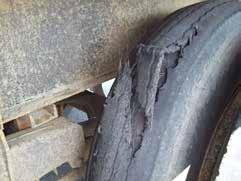
Hours-of-service regulations are in place to limit driving hours and mandate rest breaks to prevent commercial motor vehicle drivers from operating vehicles while fatigued. However, those regulations are only useful when drivers accurately reflect their times and duty statuses in their RODS.
While checking a driver’s RODS for hours-of-service compliance, inspectors will also check for:
Electronic logging device tampering, including driving while not logged in, disconnected devices and improper edits
Ghost drivers (claiming a co-driver when there is no codriver present)
Improper use of the personal conveyance special driving category
Improper use of other exceptions, including adverse driving conditions
Recording off-duty time while performing work for a motor carrier or non-motor carrier
Inspectors are available to answer questions about tire maintenance and violations, and to help drivers and motor carriers navigate the hours-of-service regulations in their jurisdictions.

By Adrienne Gildea, CAE, Deputy Executive Director, Commercial Vehicle Safety Alliance
The National Highway Traffic Safety Administration recently released encouraging new crash data, reporting that traffic fatalities declined 4.4% in the first three quarters of the year, completing the tenth straight quarter with a decline in fatalities. In addition, the agency had earlier reported a slight decrease in crashes involving commercial motor vehicles (CMV) from 2022 to 2023.
While these numbers are encouraging, and certainly every life saved should be celebrated, the number of people who die or are seriously injured on our roadways remains too high overall and much work is required to drive down those figures. CVSA is committed to partnering with industry stakeholders and federal officials to build on these recent reductions.
This year promises to be significant for CMV safety. We have a new administration and a new Congress, controlled by Republicans on both sides of the Hill. And it’s also time to start talking about reauthorization for the surface transportation bill.
In the first quarter of 2025, the new administration focused on improving government efficiency, reducing overall federal spending, and pausing and rolling back regulatory action at the federal level. It remains to be seen how this shift in focus will impact efforts by the states, CVSA and other stakeholders to continue to reduce crashes, injuries and fatalities involving large trucks and buses.
For example, over the last several administrations, the U.S. Department of Transportation (DOT) has issued several updated versions of its Automated Vehicles Comprehensive Plan, setting a framework for how automation will be incorporated into transportation. In conjunction with these efforts, in recent years, work has been underway at the Federal Motor Carrier Safety Administration (FMCSA) to prepare for CMVs equipped with automated driving systems (ADS) in interstate commerce. CVSA worked with the ADS community, motor carriers and our federal partners to envision how the North American Standard Inspection Program will be applied to ADS-equipped CMVs, resulting in the CVSA Enhanced Inspection Program.
However, effective implementation of this technology will require guidance from U.S. DOT, as well as clear determinations of how the Federal Motor Carrier Safety Regulations (FMCSR) apply to ADS-equipped CMVs. In addition, work was underway at the U.S. DOT to implement federal regulatory requirements for automatic emergency braking systems on CMVs, a requirement that CVSA and many in the industry generally support. Moving forward with either of these initiatives would clearly mean new regulations and guidance; however, it’s unclear how this will reconcile with the administration’s requirement that whenever an agency promulgates a new rule, regulation or guidance, it must identify at least 10 existing rules, regulations or guidance documents to be repealed.
Despite these questions, CVSA is encouraged by FMCSA leadership’s engagement and commitment to our shared mission of reducing crashes, injuries and fatalities involving CMVs, and the Alliance is dedicated to supporting the agency’s efforts to streamline regulations and improve efficiency while ensuring safety on our roadways. There are a number of opportunities to refine, revise and update existing regulations, providing better clarity for enforcement and industry and improving the overall effectiveness of the FMCSRs.
Meanwhile, on Capitol Hill, work has begun in earnest on the next highway bill. U.S. House of Representatives Transportation and Infrastructure Committee Chairman Sam Graves has committed to completing a surface transportation bill this year, working to ensure final passage of a reauthorization package before the end of the 119th Congress. Just
weeks into the new Congress, the committee began a robust hearing schedule, seeking to gather stakeholder input as members and staff begin crafting a bill.
In addition, the committee staff has held a series of listening sessions. CVSA joined other CMV representatives for a listening session in February and provided committee staff with an overview of the Alliance’s legislative priorities for the next highway bill, including grant reforms, a universal electronic vehicle identifier requirement, improvements to personal conveyance regulations, establishing minimum motor carrier qualification standards and changes to the New Entrant Safety Assurance Program, to name a few.
While the chairman has committed to completing the committee’s work on an aggressive timeline, it’s unclear if the overall political climate in Congress will allow for passage of a transportation bill. Congress continues to be divided and larger issues, such as overall spending levels and foreign affairs, draw significant attention, leaving stakeholders wondering if Congress will have time to move a highway bill.
The good news is that, historically, transportation policy – and safety initiatives in particular – have been largely non-partisan. Everyone understands the importance of our transportation network and together, we want to make sure all roadway users make it home safely at the end of the day. With these universal, shared goals in mind, CVSA and its members remain committed to carrying our message to Congress and the administration to continue to advance CMV safety. n

Increasing transportation safety is a universal goal.

By Perry Carter, Professional Driver, Cargo Transporters Inc.; America’s Road Team Captain
Driving a tractor-trailer is not just a job for me; it is a journey through the roadways and heartbeat of America. I am Perry Carter, and I have been a professional truck driver for 34 years, the last 23 years with Cargo Transporters Inc. I have logged 2.8 million crash-free miles and served in the United States Air Force for six years. I have been fortunate enough to deliver six Loads of Honor to Arlington National Cemetery. Last fall, I was asked to be a part of the 2024 Honor Convoy for Wreaths Across America. This convoy is known as the country’s longest veterans’ parade and kicks off a week before National Wreath Day in Maine. This weeklong journey was life-changing for me and continues to motivate me.
The Honor Convoy consisted of 140 people in 13 tractor-trailers and more than 50 passenger vehicles who traveled together for seven days. We started in Maine and traveled through 10 states along the Eastern Seaboard and visited with countless Americans. Our journey culminated at the Arlington National Cemetery, with our convoy delivering over approximately 62,000 ceremonial wreaths.
Traveling in a two-mile convoy meant a lot of planning, and there was a dedicated team to execute those plans. Being a member of the convoy meant daily morning briefings, given by Janine Roberts, retired Portland, Maine, chief of police. Roberts covered the daily itinerary, and we were given daily reminders of our following distance. With a group this large, we could not afford to have the accordion effect happen in our convoy.
The accordion effect is a phenomenon wherein the vehicles stretch out, the convoy separates and then comes together too quickly and closely, often leading to unnecessary braking and acceleration. We were given an idea of the general speed we would travel that particular day, and if things changed, we were updated via radio to adjust our speeds. Adjusting speed could mean as small as an adjustment of only one mile per hour. The convoy had to be a well-oiled machine to accomplish our daily goals. Each day, the convoy had about three scheduled stops, and pre-trips and post-trips were mandatory to keep our vehicles convoyready.
Imagine trying to coordinate fuel stops and parking with that many vehicles, which is what Chief Roberts and her group also managed. After our daily events came the task of parking the group. In New Jersey, our parking plan changed. Chief Roberts and her group pivoted and found parking at a local mall. This change was a blessing in disguise; while there, we practiced our staging for the event at Dover Motor Speedway. This Dover Motor Speedway stop was a highlight for many, including founder of Wreaths Across America Morrill Worcester. The Speedway event ended with red, white and blue fireworks, just like a true race. Mr. Worchester was able to raise his flag and announce, “Ladies and gentlemen, start your engines,” to which we all obliged him.
We all see the division that mainstream media and our social media feeds us daily, but through participating in the Honor Convoy, I saw united communities and patriotism in the
young and old, which brought tears to my eyes and brought a renewed sense of patriotism to me. To see each community’s streets with people waving American flags was amazing. I only wish everyone could experience this warm patriotic embrace. Wreaths Across America’s mission is to “Remember the fallen, honor those who served and teach the next generation the value of freedom.”
Behind the wheel, in the convoy, I am more than a truck driver – I am a steward of memories, entrusted with a solemn duty to ensure that these wreaths reach their destination with dignity and respect. The weight of the cargo I carry is not just measured in tons but in the collective gratitude of a nation.
To learn more about Wreaths Across America, go to www.wreathsacrossamerica.org. n

By Dave Elniski, PhD Student, CTSP, CRSP, ATCL, Industry Advisor, Safety and Compliance, Alberta Motor Transport Association
Institutional knowledge is the knowledge (memory, understanding of concepts, internal and external awareness, expertise, experience, etc.) that organizations have at any one moment in time. It’s essentially the sum of all the relevant knowledge of each individual staff member – or perhaps just those individuals in positions where they can share such knowledge.
What’s neat about institutional knowledge is that it resides within the minds of staff. Even an organization with impressive archives of its many decades of existence only has what institutional knowledge exists in the minds of its current staff. In other words, all the historical information in the world doesn’t matter if no one in the organization remembers where it is or knows how to access and use it.
Truck and bus carriers operate in a complex regulatory environment. They are expected to do many different things at specific times (like updating vehicle registration details) or due to specific events (like reporting a collision). Even if the duties of some individual positions are fairly focused, people still have to manage many different tasks, which are generally grouped into categories like safety/fleet safety versus occupational health and safety/ operations/dispatch/management.
Oftentimes, new compliance requirements result in new administrative tasks for carriers, meaning some individual must take on some or all of the new tasks as part of their regular job duties. Many carrier office environments are stressful, which isn’t surprising given the chaotic nature of logistics, and compliance requirements often don’t generate the sort of interest in management that might be seen in, for example, a potential new market or customer. When this is the case, a new compliance task may be quickly and unceremoniously delegated to the first staff member with the right title (or the individual who first brought up the issue).
When things like this happen, a new task has been created, and institutional knowledge has been expanded. The organization has a new thing that it must do as part of its operations, and it will be successful as long as the specific tasks live within the work-related consciousness of at least one staff member. Ideally, management assigns this staff member the responsibility of documenting what is required for this task and sharing the information internally so these details don’t just live within one person’s mind and

Institutional knowledge matters: it’s what allows a company to carry out its affairs, solve problems, and provide products and services.
notebook. But often, this doesn’t happen, and the task gets done only because someone on staff remembers to do it as part of their job, and they do it in a way that makes sense to them but not necessarily to anyone else.
Hopefully, my point on the risks related to institutional knowledge is becoming apparent. Over time, should many individual compliance tasks be similarly (and haphazardly) delegated without documentation and cross-training, the departure of a single staff member may be all it takes for a serious loss of institutional knowledge. Carriers experience this all the time whenever a senior staff member exits the organization – even when the departure was forewarned – with no succession plan in place.
Institutional knowledge is essential, and organizations should guard and maintain it like any other valuable asset. This is easier said than done, though, especially when resources are tight and there is no one around who can take the time to create the necessary systems to maintain institutional knowledge outside the minds of individual staff members. Unfortunately, these sorts of organizations, like smaller trucking companies, often operate in hypercompetitive environments where Monday’s goal is to make it to Friday, and such cultures aren’t conducive to the planning work needed to preserve institutional knowledge and create succession plans unless time is carved out for the right people to take on such work.
Institutional knowledge matters: it’s what allows a company to carry out its affairs, solve problems, and provide products and services. But it’s more the product of effective teamwork and information management than it is the product of a few key people. Sure, someone may be able to manage a great deal of compliance and operational duties with great competency, but such an individual is also a risk if there isn’t anyone else who can quickly replicate what they do. When I was an artillery soldier, a significant amount of cross-training took place within the gun detachment so that even those with more specialized roles could still quickly take the place of another person should the need arise; such systems make sense in just about any organization, not just the army. Similarly, great sports teams need effective coaching, not just star players, to play at their best.
This is the curious nature of institutional knowledge. It is robust in that it always exists as the sum of the occupational knowledge of all current staff, yet it tends to be extremely fragile and vulnerable to risk without trust, communication and systems to manage it beyond the notebook of a sole, key individual. n
By Mark Savage, ATA Law Enforcement Advisory Board Chairman; Director of Connected Truck Solutions for Drivewyze, by Fleetworthy

If you watch old-time trucking movies like “Smokey and the Bandit,” law enforcement and trucking are depicted as compatible as oil and water. And, for a long while, that wasn’t far from the truth.
Today, we're witnessing a transformative shift in the trucking industry. Drivers, fleets and law enforcement have not only gotten to know each other better but have also fostered improved collaboration. This dynamic shift in how we work together promises to create safer roadways for everyone involved.
Helping drive this change is a group called the American Trucking Association’s (ATA) Law Enforcement Advisory Board (LEAB). Formed in 2021, LEAB advises the ATA federation on strategies to grow and strengthen relationships between the trucking industry and law enforcement organizations across the country. The 27-person group consists of ATA members with previous experience in federal, state or local law enforcement. The group has a diverse mix of people currently working in the private sector, state trucking associations and law enforcement. This allows us to discuss several key issues our industry faces with varying perspectives on solutions and how we can best address them. Everyone on this board volunteers their time and has a shared mission of wanting to see our roadways become safer.
LEAB meets every two months to discuss topics and current issues, and leadership frequently meets with ATA to advise and consult on issues. We also talk with state trucking associations to address issues at the local level.
So, what are the hot topics LEAB is working to address?
Safe parking has been and continues to be a big concern, so efforts in that area are ongoing. It’s a top issue on our list, but I’m happy to report that the U.S. Department of Transportation recently provided $300 million to bolster commercial motor vehicle parking in seven states.
Still, more needs to be done. The parking problem can’t be underestimated. Trucks still park on the sides of on/off ramps because no spaces are available. This creates a security and safety problem, and it’s especially problematic for female drivers. In addition, it can lead to cargo theft.
Cargo theft continues to be a significant and complex issue in our industry. It’s vastly underreported, but we know the cost is in the billions annually. Technology advancements are helping curtail the problem, but cargo theft can start on the brokerage side and hit at a terminal or occur on the road.
While groups such as TAT (formerly known as Truckers Against Trafficking) are making great strides in helping to identify and report traffickers (TAT has trained more than 1.9 million trucking professionals), trafficking is still an ongoing problem. TAT has been instrumental in raising awareness within the trucking industry and empowering drivers to be vigilant against human trafficking.
However, the scale and complexity of the problem mean we need continued dedication and collaboration across various sectors. It’s essential to remain vigilant and proactive in addressing the causes and contributing factors to eradicate human trafficking from its roots. In the coming year, the LEAB will explore various opportunities that will address the problem.
One significant change that has helped create more teamwork between fleets and law enforcement is technology. The new tools available now really help fleets, which in turn help law enforcement. Younger drivers and those working with fleets are especially techsavvy and not intimidated by trying something new.
Take weigh station bypass services, for example. When that was first introduced to the industry, many old-school law enforcement officers weren’t so sure about weigh station bypass technology or how it could help at weigh stations. Officers wanted to inspect vehicles and didn’t want to bypass any trucks. But they’ve come around to understand how weigh station bypass allows them to spend more time inspecting vehicles that truly do need inspecting.
Now more than ever before, the private sector, law enforcement and other stakeholders are coming together to work through the challenges faced by the commercial trucking industry. We all want safer roads and a stronger industry for all, and the collaborative efforts through LEAB are helping make that happen. n
By Jim Rhodes, Director of Commercial Vehicle Operations, Perceptics
According to the Pipeline and Hazardous Materials Safety Administration, over 1 million hazardous materials shipments traverse the U.S. every day, yet most communities lack the tools to track these potentially dangerous shipments as they travel next to other vehicles, homes, schools and offices. Current tracking methods typically require manual commodity flow surveys performed over a brief period. These methods are subject to human error and often do not clearly represent hazmat data and trends. That's where hazmat placard reader technology excels. Using advanced artificial intelligence, hazmat placard readers can automatically detect hazard class, division and UN numbers, making hazmat tracking more reliable and convenient.
Consistent, accurate hazmat tracking can significantly improve safety and preparedness in your community because safety starts with knowledge.
When emergency managers know what hazardous materials have traveled through a particular area, they can identify trends that help them prepare for and prevent incidents through data-backed risk mitigation plans. Additionally, real-time hazmat information can help reduce the likelihood and severity of crashes and even save lives by enabling prompt response and intervention. Through cross-agency sharing, emergency responders can benefit from accurate, real-time hazmat data that ensures prepared response teams.
Investing in hazmat technology also provides long-term benefits. It can build community trust through proactive intervention and transparency. And with time and proper planning, it can also provide environmental benefits, helping to prevent hazmat incidents and keep toxic materials out of air, soil and water supplies.
There are several ways to deploy hazmat placard reader technology, whether as a fixed solution for ongoing tracking or a portable solution for automated commodity flow surveys. Let's explore a few of the ways hazmat readers can improve safety and operational efficiencies.
1. Streamlined Commodity Flow Surveys
Current commodity flow surveys are often
Over 1 million hazardous materials shipments traverse the U.S. every day.

resource-intensive and infrequent, limiting their effectiveness. However, hazmat trackers can transform these surveys from laborious to effortless. By utilizing portable roadside cameras mounted on solar-powered trailers, hazmat trackers can capture and read crucial hazmat placard data – including the hazard class, division and UN number – from multiple placards per vehicle.
This streamlined approach to commodity flow surveys enables communities to conduct more frequent and reliable surveys with minimal effort. This data can help develop policies regarding hazmat transportation routes and restrictions and enable officials to build trust in the communities they serve through transparency and action. Additionally, automated commodity flow surveys free up both human and financial resources to be reallocated to other important initiatives.
2.
Monitoring While periodic commodity flow surveys might be sufficient for smaller counties and municipalities, state agencies may want the ability to continually monitor hazmat truck shipments traveling on main interstate routes. In this case, we recommend deploying hazmat placard reader technology on fixed cameras at weigh-in-motion sites or other key areas.
A fixed hazmat tracking solution enables agencies to capture, analyze and report data in near real time, allowing them to uncover trends over time. This provides a wealth of
insight into hazmat freight that has not been thoroughly explored. Fixed deployments may significantly enhance roadway safety and emergency response efforts when combined with other vehicle recognition solutions, such as license plate readers or USDOT number recognition readers.
3. Improved Mitigation and Enforcement
Automated hazmat placard recognition is also a practical option for state and county patrols looking to spot unsafe hazmat travel. Portable hazmat placard reader cameras enable officials to capture hazmat freight traveling in key zones. For example, they may need to ensure that hazmat shipments do not pass through restricted areas, such as bridges, tunnels and zones where a hazmat incident could pose a risk to the public.
Agencies can also use this technology to alert patrol vehicles further down the road when a truck carrying a hazmat shipment approaches a restricted zone. The trailer could capture images of the hazmat placard and trigger an alert in real time, allowing the patrol vehicle to intercept the hazmat vehicle before entering the restricted area.
In short, the days of unreliable hazmat tracking are over. With automated tracking solutions, agencies can ensure unparalleled safety, transparency and preparedness in their communities while expending less time and effort. Remember, safety starts with knowledge. n
By Phil Baxter, Assistant Vice President – Risk Engineering and Strategy; Crum & Forster
Crum and Forster’s (C&F) Transportation Division has partnered with roadside enforcement officers to educate underwriters, actuaries and numerous other insurance professionals about the reality of roadside inspections. As the assistant vice president of risk engineering, I’ve been involved in trucking industry events and organizations, and over the past few years, I’ve created a partnership between the C&F team and law enforcement.
In June 2024, Ofc. Chris Vinson, with the Midlothian (Texas) Police Department (PD), spoke to the C&F team via a video call to describe the roadside inspection process and the origin of data that the insurance industry utilizes daily. Ofc. Vinson spoke about selecting trucks for inspection, explained the inspection process and answered questions from the C&F team.
In July 2024, Dana Moore from the Texas Trucking Association spoke to the C&F team via video presentation. Dana presented information about Mexico’s Licencia Federal de Conductor (sometimes called a Mexican commercial driver’s license (CDL)), border issues in trucking and other Texas-specific topics. The experience was very eye-opening for underwriters who had never heard firsthand experiences from the Mexican border or about Mexican CDLs.
In January, I joined C&F underwriters from Michigan and New Jersey to attend roadside inspections with Ofc. Tom Mrozinski of the Frisco (Texas) PD.
The underwriters were surprised by the level of detail Ofc. Mrozinski displayed in his inspection. The underwriters gained knowledge in several areas throughout the inspections – including tread depth, air leaks, load securement and fluid leaks. The insurance professionals commented that it was invaluable to witness a roadside inspection in person after reviewing the data as part of the underwriting process and that it provided them a new level of understanding and appreciation for roadside officers, drivers and mechanics.
In my personal experience, I’ve found the partnership with roadside enforcement to be valuable on multiple levels. My team and I speak to trucking company officials as part of our duties, and there are often complaints that an officer will always find something

or that it’s impossible to pass a roadside inspection.
When the C&F risk engineer invites the company to partner with law enforcement instead of viewing them as opponents, the narrative changes. In some cases, direct company-enforcement partnerships have been formed, and in other cases, C&F’s risk engineers act as liaisons between insured
companies and the roadside enforcement community for education purposes.
Regardless of how C&F can bridge the gap, I consider it a win for both enforcement and the insured company – and ultimately, roadway safety – when the industry and roadside enforcement work together. n
By Sulev “Swede” Oun, Owner, O&K Truck Repairs
This article is written to encourage people to take the time to thoroughly go through the Federal Motor Carrier Safety Regulations (FMCSR). After all, these regulations dictate how we operate and enforce safety for our roadways.
We will focus on federal annual periodic inspections versus state-equivalent annual inspections. I will use New York as an example because that is where I reside and work. However, you can substitute any U.S. state, recognizing that each state has its own regulations.
I am fortunate to have developed a level of comfort with various subjects relating to our industry, so much so that people often call me with questions and issues, hoping to gain some clarity. Now, I do not know everything; I learn from all of you who call me. I enjoy researching and utilizing what little I know from real-world experiences to come up with
possible answers. Many of you reciprocate, especially the enforcement community in my state. Most questions pertain to regulations, violations, etc. I frequently see a trend in the type of questions, and annual inspections versus state inspections is one such trend.
I know what the regulations require, but at the same time, there’s the real world, where there is confusion concerning certain requirements – and to be honest, it’s understandable when it comes to exceptions and interpretations. A few years ago, I did some regulations training for the Northeast Equipment Association. Traveling to the states they serve required me to dig deeper into some nuances specific to each state, even though most of the regulations pertained to the FMCSRs. Again, I don’t know everything.
The specific question that seems to come up is, “Do I need a federal annual inspection, a New York state inspection or both?” Many people I
talk with refer to the federal annual inspection as a U.S. Department of Transportation inspection.
First, interstate commerce is regulated by the U.S. federal government and covered by the FMCSRs. However, states also adopt parts or all of these regulations for intrastate commerce. Therefore, state regulations quite often are dependent on the FMCSRs. New York state, as well as several other states, started adopting the FMCSRs as a whole quite a few years ago.
Let’s look at those pertaining to annual inspections.
• "§ 396.17, Periodic Inspections: Every commercial motor vehicle must be inspected as required by this section. The inspection must include, at a minimum, the parts and accessories set forth in Appendix A to this part."

Regulations are needed to ensure that safe vehicles travel on our highways.
Note: There’s a little bit more to this, but I am trying to keep this short and simple. Please take a look at § 396.17 and Appendix A for more information.
So, let’s look at a couple of subparagraphs under § 396.17 for the states.
• Like many federal regulations, there is an exception. Subparagraph B allows for an inspection conducted under § 393.23. Turning the page to § 393.23, we read, "If a commercial motor vehicle is subject to a mandatory inspection program that the administrator determines to be as effective as § 396.17, the motor carrier… must meet the requirement of § 396.17 through that inspection program."
• Subparagraph F also states: "Vehicles passing periodic inspections performed under the auspices of any state government or equivalent jurisdiction in the Canadian provinces, [etc.], meeting the minimum standards contained in Appendix A to this part, will be considered to have met the requirements of an annual inspection for a period of 12 months commencing from the last day of the month in which the inspection is performed." By the way, keep this statement with the date in mind. It will be relevant.
Now, knowing about adoptions and requirements leads us to state inspections. There are 23 states that have their own state inspection program equal to or greater than the requirements in Appendix A, allowing their inspections to be accepted as meeting the federal inspection requirements. Some states deviate somewhat to make them a little more stringent. Keep in mind that federal inspection is a minimum requirement. For states, it is quite a task to put together a state inspection program.
Quite a few years ago, I got subcontracted to put together an inspection program in one of the Northeast states so they could become one of the 23 states with inspection programs equal to or greater than the federal requirements. It was quite a challenging task to dot the i’s and cross the t’s. The states tend to be more precise and require stricter standards from their inspectors. Consequently, and rightfully so, some states incorporate a training element with their programs.
New York has a straightforward requirement. Basically, if you are a New York-based/ registered vehicle, it will require a New York annual inspection. Because New York is one of the 23 states, these inspections should be recognized nationwide as meeting the federal annual inspection requirements as per § 396.17. However, in the real world, one hand doesn’t know what the other is doing. Consequently, the vehicle will go through some states other than New York where it might get pulled over for a roadside inspection, and you might get a violation for not having an annual inspection, even though a New York inspection sticker should be a clear indication that it passed the equivalent of an annual inspection.
Many companies get frustrated by this, and it’s not hard to see why. To avoid these types of situations, I have talked some companies into getting both a federal annual inspection and a state inspection. This way, they are covered no matter what jurisdiction a driver travels through. It’s a shame because an inspection performed by a certified inspector will be a more thorough inspection than a federal one, where you can go to any truck stop or parts store and get a sticker/form and fill it out by anyone capable of using a pen. Yes, I know all about § 396.19, Inspector Qualifications, and I can write a whole article about just that. The big question is, “Why the disconnect?” Let’s take that deep dive together.
Q: On the inspection sticker, can we put the due date for the next inspection rather than the date the last inspection was performed?
A: No. The inspection report and decal must show the date the inspection was performed.
From § 396.17: The documentation may be: (1) The inspection report prepared in accordance with § 396.21(a) or (2) Other forms of documentation, based on the inspection report (e.g., sticker or decal), which contains the following information: (i) The date of inspection (ii) Name and address of the motor carrier.
In New York, the only thing different from the federal criteria is the date on the sticker. The federal inspection requires the date of the actual inspection. New York uses the date when the next inspection is due. However, in New York, the computer-generated report has all the appropriate information, such as when the inspection was performed.
Carefully reread those sections and the guidance and try to figure out this predicament. The state and federal inspections are identical. The only difference is the sticker showing the date performed or the date due. It’s not rocket science to figure out that if a sticker has the due date; you simply go backward and figure out the actual inspection date. No matter how you think about it, 12 months is 12 months.
The confusion comes from the guidance. The problem is that the guidance references the requirements of § 396.17 Subparagraph C and is not applicable to a state program under § 396.23. Remember when we started unraveling this, we followed the exception in Subparagraph B that took us to § 393.23. Within § 393.23, the motor carrier must meet the requirements of § 396.17 through the mandatory inspection program. This would mean that the sticker that meets the requirements of the New York program would meet the requirements of § 396.17, leaving us asking why a violation has been written. The vehicle cannot be excepted from § 396.17 via § 396.23 and, at the same time, be subject to § 396.17 and § 396.17 guidance.
I will leave you with one final thought. Regulations are needed to ensure that safe vehicles travel on our highways. An annual inspection is meant to guarantee that at least once per year, no deficiencies have slipped through the cracks and all issues are fixed. My two cents: the annual periodic inspection requirements need to be revisited, updated and worded clearly enough to ensure that every carrier, inspector and technician clearly understands the requirements.
What do you think? Again, I don’t know everything. I could be wrong with my conclusion. Go through it yourself as a journey of discovery. Maybe we can learn something new together. n
By Ron Cordova, Director of Safety and Compliance, Zonar
A troubling pattern emerges each year when the Federal Motor Carrier Safety Administration releases its list of vehicle out-of-service (OOS) violations. The same preventable issues consistently top the list: problems with tires, brakes and turn signals –issues that drivers could have caught during routine pre-trip inspections.
While the trucking industry rightfully focuses on combating driver fatigue, distracted driving and speeding, another serious safety threat often goes unaddressed: inspection complacency. The consequences of this complacency are reflected in 2024's top OOS violations, which include flat tires, defective brakes, improper tire inflation and inoperative turn signals. A thorough pre-trip inspection would have provided an opportunity to address these concerns.
When violations are discovered during roadside inspections, drivers may be placed OOS, leading to costly delays. If a driver is caught 100 miles from a major city with a broken brake light or other minor violations, the costs of towing, repairs and lost time can add up quickly. These situations often
result in unpredictable and expensive charges, sometimes even leading to predatory towing practices, where the cost of a simple tow is inflated based on the vehicle’s weight and distance.
These costly outcomes highlight the critical need for a proactive approach to safety, starting with thorough pre-trip inspections.
A safety mindset begins with earning a commercial driver’s license (CDL). While truck driving schools and community colleges provide comprehensive training that includes classroom instruction, theory and behindthe-wheel practice, there is no nationwide requirement for ongoing education after certification. Although the CDL skills test emphasizes thorough pre-trip inspections, for many drivers, this may be the most detailed inspection they ever perform. Over time, preand post-trip inspections are often perceived as mere chores or “unnecessary steps,” especially by experienced drivers facing mounting pressure to meet delivery deadlines.
Creating a sustainable safety culture requires strategic hiring, continuous training and consistent reinforcement. "One-and-done" training programs fall short. Instead, fleets need to implement regular refresher courses that cover evolving safety regulations, company policies and industry best practices. This ongoing education helps veteran drivers maintain their skills while ensuring new hires develop proper habits from day one. The trucking industry must cultivate a safety mindset that empowers every driver –regardless of experience level – to follow safety guidelines and checkpoints thoroughly every day on the job.
"Pencil-whipping" – rushing through inspection forms without conducting thorough checks – undermines fleet safety and operational efficiency. High-pressure delivery schedules and assumptions about vehicle conditions often exacerbate this issue, leading drivers to neglect critical safety practices.
Modern telematics, including driver vehicle

With the right technology and incentives, fleets can build a culture in which safe, thorough inspections are a driver’s top priority.
inspection reports or electronically verified inspection reports (DVIR/EVIR), offer practical solutions. These systems ensure drivers conduct detailed checks of essential components, from tires and lamps to wipers and low-air warning signals, while streamlining the documentation process.
Unlike traditional paper-based systems, EVIR provides real-time visibility into inspections, helping managers identify rushed or overlooked steps and ensuring thoroughness.
By integrating DVIR/EVIR technology, fleets can catch defects before they lead to costly downtime, reduce human errors common with paper inspections, and improve the speed and accuracy of inspections. Despite the perception that inspections add time, DVIR/EVIR streamlines the process, reducing inspection time by up to 50% compared to paper-based methods. Additionally, it helps avoid the time and expense of roadside inspections, maintenance or towing if a vehicle is found to be unsafe or improperly maintained. Beyond operational efficiency, these tools also ensure drivers meet legal requirements for completing and documenting inspections, protecting both drivers and employers from fines and safety violations.
One challenge in improving inspection compliance is aligning driver incentives with safety goals. In large fleets, drivers may feel disconnected from the financial consequences of vehicle breakdowns, while owner-operators, who are paid only when their wheels are rolling, may view inspection time as lost income. Both scenarios can lead to dangerous shortcuts.
Cutting corners on safety and inspections can ultimately result in costly violations; raised Compliance, Safety, Accountability (CSA) scores; reputational damage; and higher insurance premiums.
Progressive fleets are tackling this challenge with innovative incentive programs. Fleets can use telematics data to track and reward positive driving behaviors through gamification. Additionally, video telematics is playing an increasingly important role in driver coaching. By using in-cab cameras and real-time feedback, fleets can provide drivers with immediate guidance on unsafe behaviors. This visual coaching helps drivers self-correct in
real time, reducing the likelihood of citations and crashes.
With the right technology and incentives, fleets can build a culture in which safe, thorough inspections are a driver’s top priority and unsafe driving habits are addressed before they become costly.
Cutting corners on pre-trip inspections might save minutes, but it can lead to costly OOS violations, increased downtime, increased insurance premiums and reputational damage. Drivers can also face personal liability for operating unsafe vehicles, including potential fines and citations.
By investing in comprehensive training programs, leveraging modern digital inspection technology and implementing meaningful incentive programs, fleets can build a culture where safety and efficiency coexist. This approach not only reduces crashes and compliance violations but also helps attract and retain quality drivers – a crucial advantage in today's competitive market.
The path to safer fleet operations starts with acknowledging that inspection complacency is not just a compliance issue – it's a cultural challenge that requires a holistic solution. By addressing this challenge head-on, fleets can protect their drivers and their bottom line while contributing to safer roads for everyone. n


Join International Fuel Tax Association (IFTA) Inc. at the 2025 IFTA Educational Forum for the unique opportunity to interact with fellow stakeholders, learn about the business processes affecting the administration of fuel use taxes, and participate in critical discussions that will help shape the future of IFTA and the motor carrier industry.
For more information, visit www.iftach.org/IFTAevents
PRESIDENT
Capt. John Hahn
Colorado State Patrol
VICE PRESIDENT
Maj. Erick McGuire
Florida Highway Patrol
SECRETARY
Sgt. William Alarcon
New Jersey State Police
PAST PRESIDENTS
Col. Russ Christoferson
Montana Department of Transportation
REGION PRESIDENTS
Region I
Tpr. Brian Pfarrer
New Jersey State Police
Region II
F/Sgt. Travis Ingold
North Carolina State Highway Patrol
Region III
Lt. Mike Maytum
Nebraska State Patrol
Region IV
Tpr. Chase Livingston
Arizona Department of Public Safety
Region V
Krista Cull
Newfoundland and Labrador
Transportation Regulation Enforcement
ASSOCIATE MEMBER PRESIDENT
Brett Graves, CDS
Maverick Transportation LLC
ASSOCIATE MEMBER VICE
PRESIDENT
Stephen Keppler
Scopelitis Transportation Consulting
LLC
COMMITTEE CHAIRS
Audits and Investigations Committee
Keith Kerns
Public Utilities Commission of Ohio
Crash Data and Investigation
Standards Committee
Lt. Mike Maytum
Nebraska State Patrol
Driver-Traffic Enforcement
Committee
Capt. Chris Barr
Indiana State Police
Enforcement and Industry Modernization Committee
Lt. Marcus Studer
Michigan State Police
Hazardous Materials Committee
Tpr. Joshua Anderson
North Dakota Highway Patrol
Information Systems Committee
Holly Skaar
Idaho State Police
Passenger Carrier Committee
Tpr. Brian Pfarrer
New Jersey State Police
Policy and Regulatory Affairs Committee
Maj. Jon Smithers
Indiana State Police
Size and Weight Committee
Sgt. Kendell Jackson
North Carolina State Highway Patrol
Training Committee
Lt. Ronald Jenkins
Oklahoma Highway Patrol
Vehicle Committee
Sgt. Robert Wittkowski
Iowa Department of Transportation
REGION VICE PRESIDENTS
Region I
Sgt. Abraham Rosario
Connecticut Department of Motor Vehicles
Region II
Lt. Virgil Verduzco
Texas Department of Public Safety
Region III
Lt. Christopher Keller
Michigan State Police
Region IV
Capt. Kevin Adkins
Montana Department of Transportation
Region V
Richard Robinson
Ontario Ministry of Transportation
LOCAL PRESIDENT
Ofc. Christopher Vinson
Midlothian (Texas) Police Department
LOCAL VICE PRESIDENT
Ofc. Derek Malena
Allen (Texas) Police Department
PROGRAM CHAIRS
Commercial Vehicle Brake
Manufacturers Council
Greg Dvorchak
Hendrickson International
Cooperative Hazardous Materials
Enforcement Development
Sgt. Brad Gibson
Texas Department of Public Safety
Human Trafficking Prevention
Lt. Christopher Keller
Michigan State Police
International Driver
Excellence Award
Paul Claunch
PrePass Safety Alliance
International Roadcheck
Terry Renfrow
Reliance Inc.
Level VI Inspection
M/Sgt. Todd Armstrong
Illinois State Police
North American Cargo Securement
Harmonization Public Forum
Lt. Roger Eberle
Oklahoma State Patrol
North American Inspectors
Championship
Richard Roberts
British Columbia Ministry of Transportation and Infrastructure
Operation Airbrake
Ofc. Thomas Mrozinski Jr. Frisco (Texas) Police Department
Operation Safe Driver
Jonathan Nicastro
New York State Department of Transportation
PBBT Users
Tpr. Lew Thomas
Colorado State Patrol
Collin B. Mooney, MPA, CAE Executive Director collin.mooney@cvsa.org
Adrienne Gildea, CAE Deputy Executive Director adrienne.gildea@cvsa.org
Nicole Leandro Director of Communications nicole.leandro@cvsa.org
Katie Morton Director of Compliance Programs katie.morton@cvsa.org
Kristin Yednock, CMP, DES Director of Conference and Event Services kristin.yednock@cvsa.org
Jake Elovirta Director of Enforcement Programs jake.elovirta@cvsa.org
Bill Reese Director of Hazardous Materials Programs bill.reese@cvsa.org
Kerri Wirachowsky Director of Inspection Programs kerri.wirachowsky@cvsa.org
Ken Albrecht
Director of Multimedia Development ken.albrecht@cvsa.org
Shannon Heck Director of Training Services shannon.heck@cvsa.org
Terry Kummer Crash Investigation Specialist terry.kummer@cvsa.org
Rodolfo Giacoman Fatigue Management Specialist rodolfo.giacoman@cvsa.org
Kevin Hogan Hazardous Materials Specialist kevin.hogan@cvsa.org
Matt Mullen Hazardous Materials Specialist matt.mullen@cvsa.org
Brett Dimmerling Learning Management System Specialist brett.dimmerling@cvsa.org
Carlisle Smith Level VI Inspection Specialist carlisle.smith@cvsa.org
Mark Mills Multimedia Specialist mark.mills@cvsa.org
Terry Moore Multimedia Specialist terry.moore@cvsa.org
Jeremy Disbrow Roadside Inspection Specialist jeremy.disbrow@cvsa.org
John Sova Roadside Inspection Specialist john.sova@cvsa.org
Kevin Andrews Traffic Enforcement Specialist kevin.andrews@cvsa.org
Byron Sullivan Manager of Accounting byron.sullivan@cvsa.org
Wendy Hall Manager of Administrative Services wendy.hall@cvsa.org
Dan Parks Manager of Federal Contracts and Grants dan.parks@cvsa.org
Margaret Edwards Manager of Government Affairs margaret.edwards@cvsa.org
Cassy Dafin Manager of Meetings and Events cassy.dafin@cvsa.org
David Findlay
Manager of State and Local Contracts and Services david.findlay@cvsa.org
Paola Berridi Certification Coordinator paola.berridi@cvsa.org

Angela DiLeo Membership Coordinator angela.dileo@cvsa.org
Amy Molina Training Coordinator amy.molina@cvsa.org
Emily Moorhead Writer-Editor emily.moorhead@cvsa.org
Chris Turner Judicial Outreach chris.turner@cvsa.org



























American Bus Association
Austin Powder Company
AWM Consulting Service
Brake Tech Tools
Cargo Transporters Inc.
FoxFury LLC
Hoffman Transportation LLC/G&D Trucking Inc.
Independent Carrier Safety Association
J.J. Keller and Associates
Kistler Instrument Corporation
Link Engineering Company
MANCOMM Inc.
Marathon Petroleum Company
R+L Carriers Inc.
Republic Services
Seikosoft
Techni-Com Inc.
United Motorcoach Association
UPS
Werner Enterprises Inc.
Zonar Systems
American Pyrotechnics Association
Cassidy’s Transfer & Storage Ltd.
DATTCO Inc.
Fast Enterprises
Greyhound Lines Inc.
Groendyke Transport Inc.
Hendrickson
Charles E. Boyk Law Offices LLC
General Electrodynamics Corporation
GFL Environmental Services Inc.
Jade Transportation Services
Laser Technology Inc.
Marsh McClennan Agency
Oak Harbor Freight Lines Inc.
Pressure Systems International
Railsback HazMat Safety Professionals LLC
The Davey Tree Expert Company
Institute of Makers of Explosives
Linde Gas and Equipment Inc.
Scopelitis Transportation Consulting LLC
Torc Robotics Inc.
Trimble
Truckers Yoke
Twin Lake Trucking LTD
Usher Transport
Wilbur-Ellis Co.
99 M Street, SE, Suite 1025 Washington,
AUGUST 19-23, 2025 Minneapolis, Minnesota

Join us for this year’s North American Inspector’s Championship. To learn more, visit www.cvsa.org/naic.